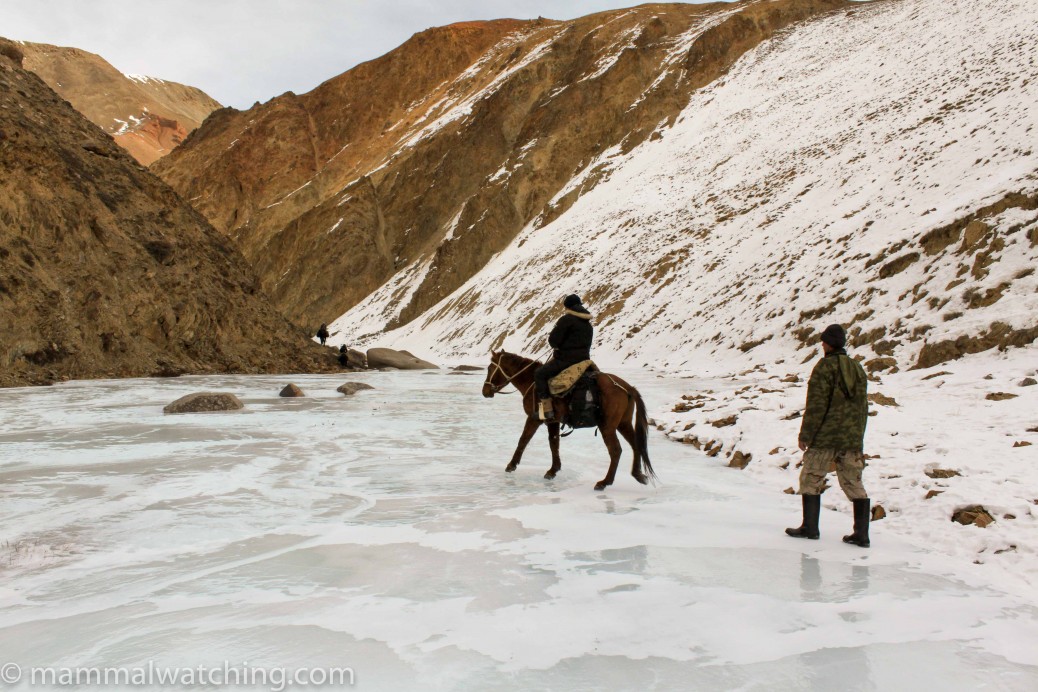
Kyrgyzstan
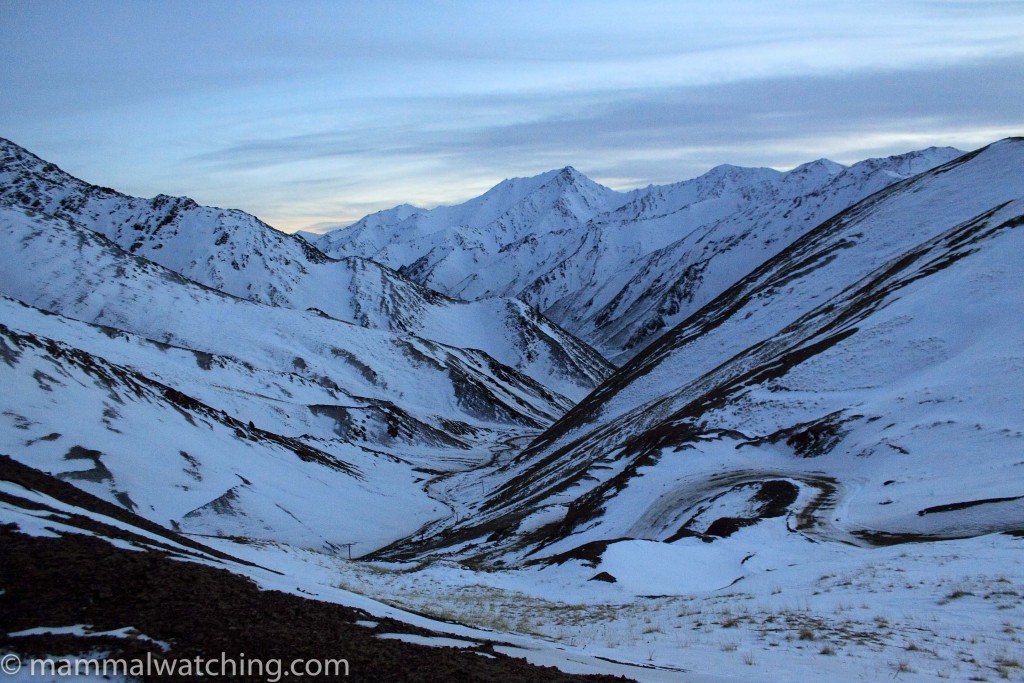
Tian Shan Mountain Pass, Kyrgyz/Chinese Border
I knew nothing about Kyrgyzstan – its mammals or otherwise. I wasn’t even sure where it was. So when, in September 2009, Adam Riley from Rockjumper forwarded me an email about an expedition to look for Snow Leopards there I wasn’t sure I should go.
But then again, seeing a Snow Leopard ranks alongside Giant Pandas as an ultimate mammal goal. And the trip – to a particularly remote area of a remote country – sounded like it would be an adventure, Snow Leopards or not. So I signed up. Three months later I was battling with the scrum at passport control in Bishkek airport.
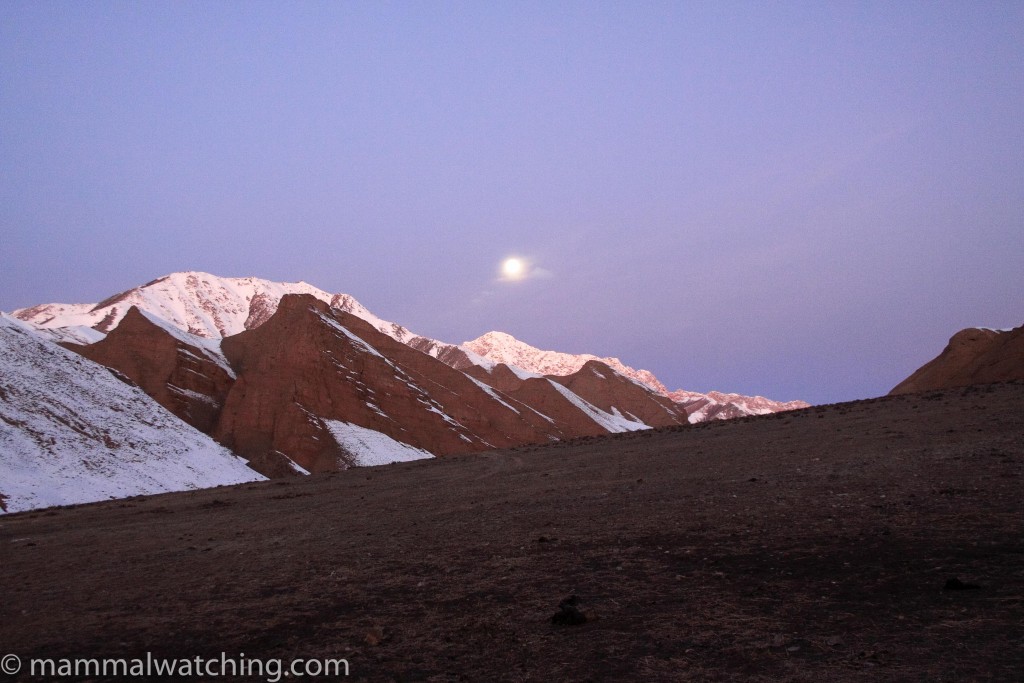
Tian Shan dawn
This trip was organised by Michael Westerbjerg Andersen, a Danish birder who has spent a good deal of time in Kyrgyzstan and was living in Bishkek. Michael has been running trips through the country for the past 16 years through his company Miksture and had seen several Snow Leopards during his travels. He’d recently seen video footage of a plateau on the Chinese border where daily counts of 4000 Siberian Ibex were not uncommon and Argali (or Marco Polo Sheep) were also plentiful. This was exceptional for Kyrgyzstan. And where there are Ibex, the Snow Leopard – or Shepherd of the Ibex – ought to be close by.
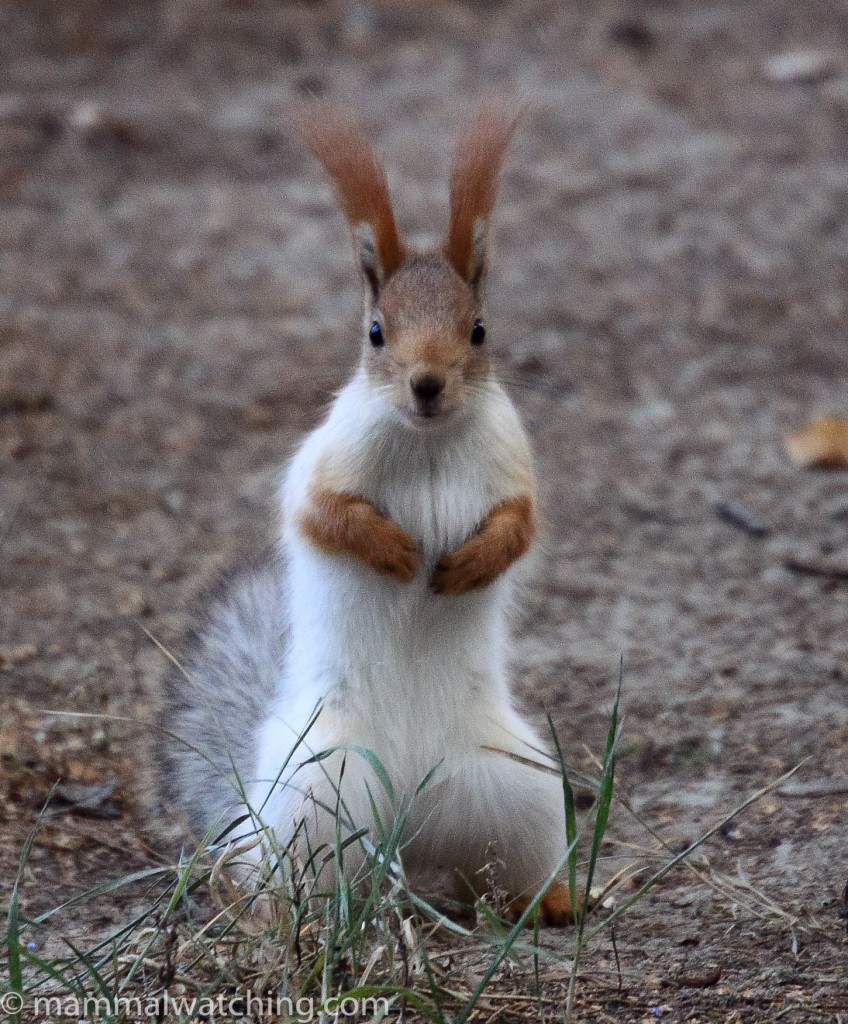
Eurasian Red Squirrel, Sciurus vulgaris
The plateau’s position on the Chinese border means it has been closed to most tourists in recent years and the only few Westerners to have visited have gone to shoot Argali (at $25,000 USD a pop) or for hard-core mountaineering. I think we may have been the first Westerners ever to go to the area in winter. But Michael’s Kyrgyz contacts managed, somehow, to get permission for us to visit. This wasn’t an easy thing to arrange.
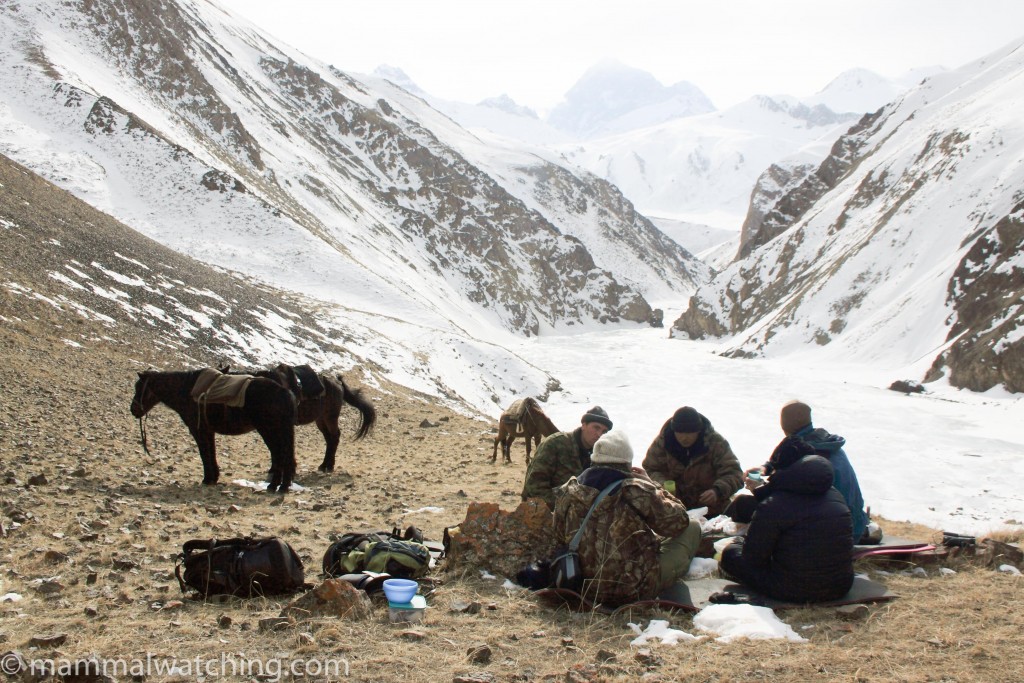
Lunch in the mountains
About Kyrgyzstan
The country is surprisingly friendly and easy to visit, and many nationalities including Australian, Danish and British can purchase a visa on arrival at the airport. The roads are quite good, prices are low, and the food is tasty too, so long as you like meat. If you like fat then it is a gourmet’s paradise: I tried sheep’s tail fat and two kinds of pork fat, all of which were good. I’m not, however, in a hurry to have another slice of pure Yak fat sausage.
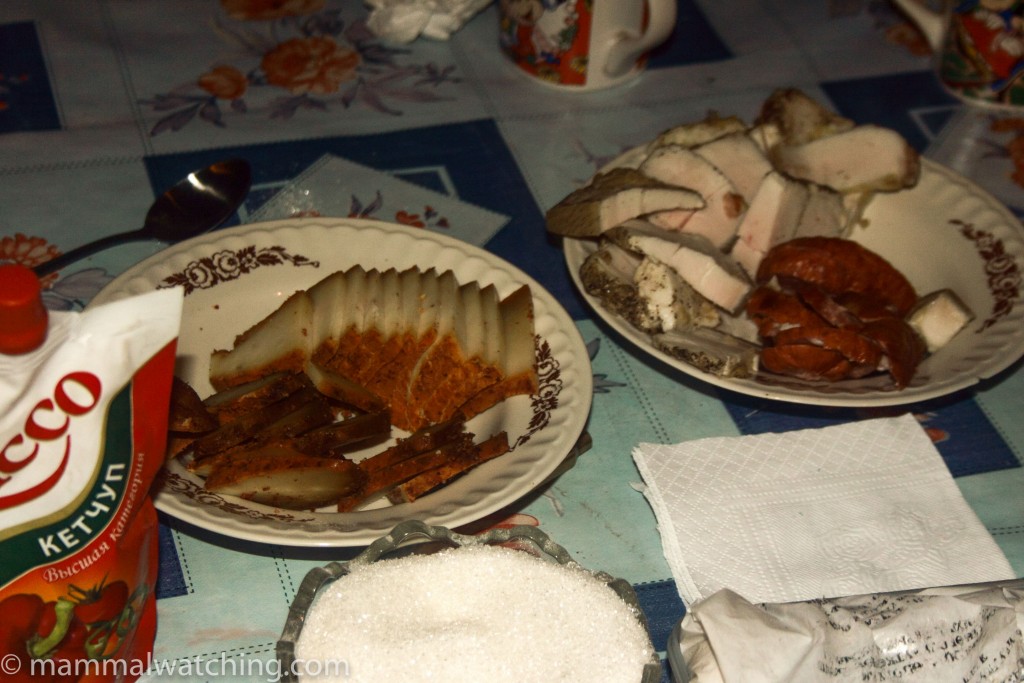
Five kinds of heart disease
In December the weather was very cold but not unbearable most of the time. Up at around 3000 metres, the nights dropped to -15 or -20 I guess (and on the way to the plateau at night it was -30 at one point which was unbearable), but it was above freezing during the mainly sunny days.
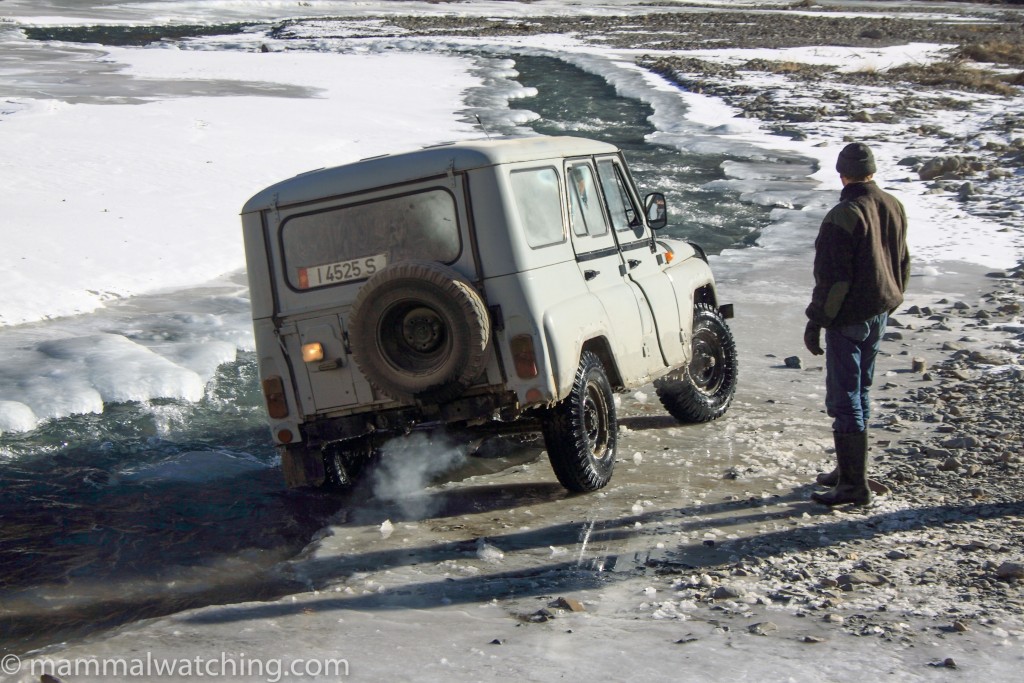
Driving in the Tian Shan Mountains
1 December
I arrived at 5 a.m. into Bishkek, an annoying time to arrive because it was midnight in Paris where I’d come from. It took a good hour and a half to get a visa and fight through the crowd of people jostling to clear immigration but I was met by Michael and whisked – as much as anything can be whisked along Kyrgyz roads – to a guest house where I grabbed 3 hours sleep and had some brekky. By midday we were changing money downtown. Bishkek, even by former USSR standards, is not an attractive city. Its contribution to global architecture ranks alongside Italy’s contribution to good government. But the people are friendly, the prices are cheap and there is stuff in the stores.
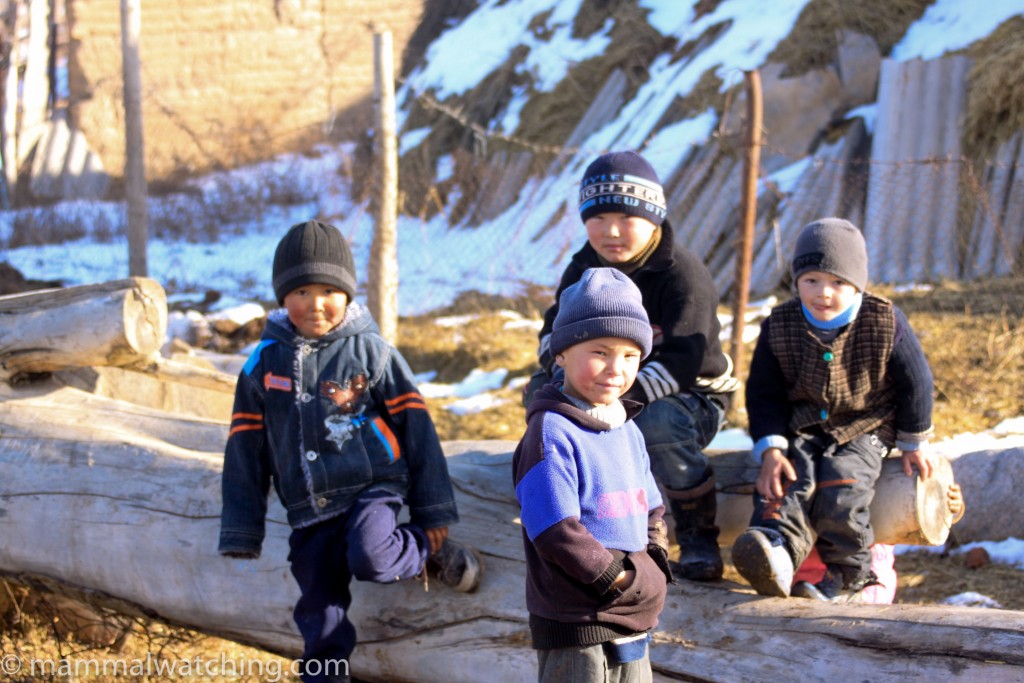
Bishkek kids
After picking up some essential supplies (beer and chips) our group – Michael Andersen, Helle Pedersen (a Danish tourist and fellow Snow Leopard fan) and me – plus various Russians and Ruslan, an alarmingly large Krygyz driver – were heading off towards lunch in the town of Tokmak, an hour out of Bishkek. We picked up a second 4WD after lunch and continued on for the mountains.
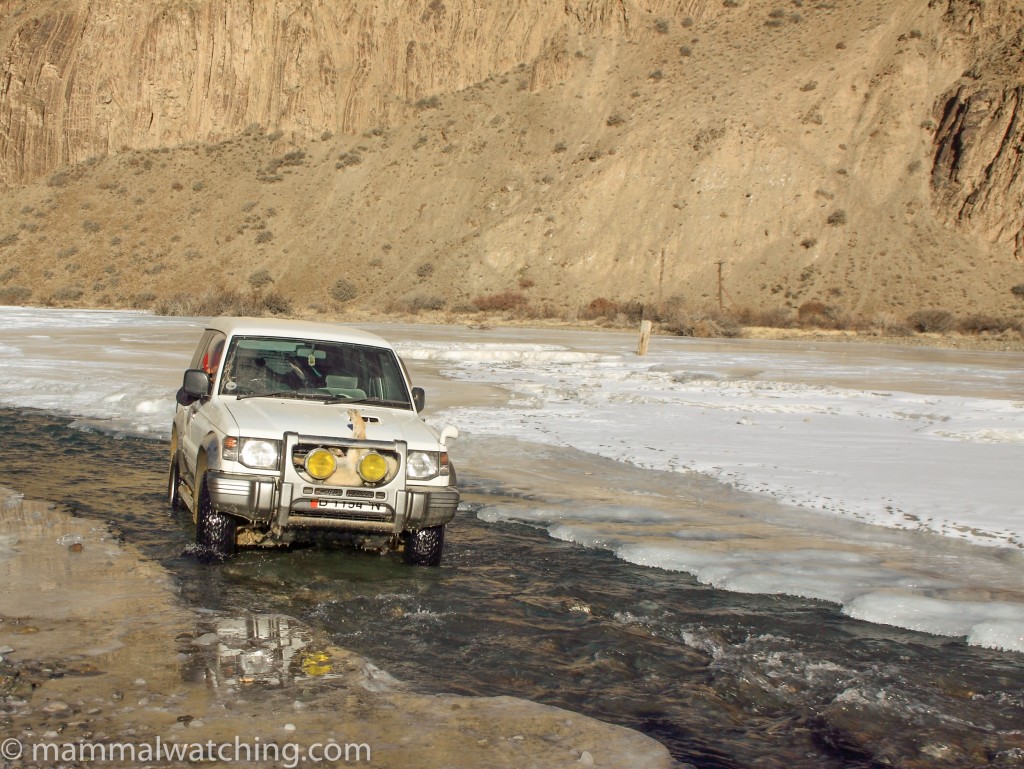
Driving in the Tian Shan Mountains
Five minutes out of Tokmak, our driver Emil noticed that four of the six bolts holding on one of his rear wheels had dropped off. Back to Tokmak. Not an auspicious start. But after scavenging some bolts from the wreckage of another Pajero we were on our way again. The Pajero wreckage was courtesy of Ruslan, the Kyrgyz owner of the hunting camp we were were travelling to. Ruslan had driven into a cliff a few weeks ago when he fell asleep. Ruslan, it transpired, was not only alarmingly large but also a seven times World Champion Kickboxer: so if he had decided to take a little nap when he was driving I could understand why anyone might be nervous about disturbing him.
That was, however, the last hitch for the day, and we then drove 3.5 hours, mainly in the dark, along the southern shore of Lake Issyk Kol, the second largest mountain lake in the world, after Titicaca. We spent the night in a comfortable guest house in Tamga. Kyrgyz soup is excellent.
2 December
I had some very strange dreams in the night featuring people I hadn’t seen in years. Apparently this is common here – maybe it was the altitude, maybe it was the soup or maybe it was the random bursts of Michael’s snoring.
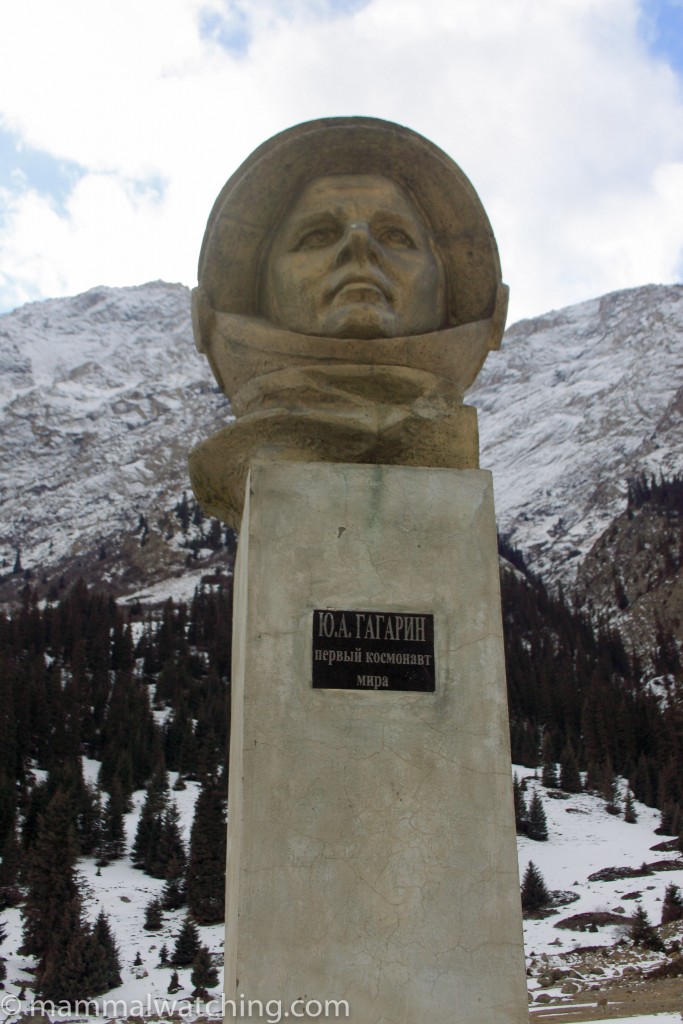
Monument to Yuri Gagarin
We were supposed to leave at 8 a.m. By 10 a.m. the rest of the party was still ‘an hour away’ so Michael took us to a once famous spa hotel near the guesthouse. Yuri Gagarin used to holiday here and the Soviet Olympic athletes also trained here. It is also home to a lot of squirrels which I assume are a rather strange looking subspecies of Eurasian Red: their colouration is certainly very different to any of the Red Squirrels I have seen in Europe. Maybe they’d been feeding on the athletes’ left over steroids.
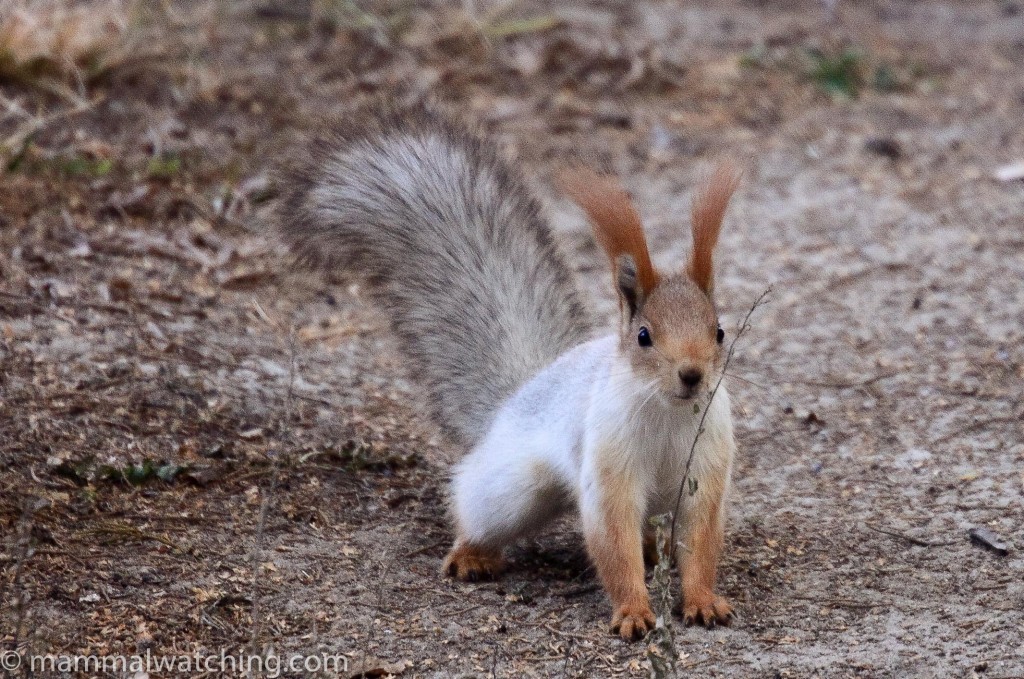
Eurasian Red Squirrel, Sciurus vulgaris
Ruslan and the rest still hadn’t arrived by 2pm and no one was quite sure why so we headed out of the guesthouse and along the road south to the big Goldmine where we began to see our first spectacular scenery. Ruslan, and the two other vehicles eventually arrived at 5pm. It turned out that our permission to head to the Chinese border required one final signature that morning. But the signer had disappeared so Ruslan had spent the whole day trying to find him to get the signature. Such is life in Kyrgyzstan.
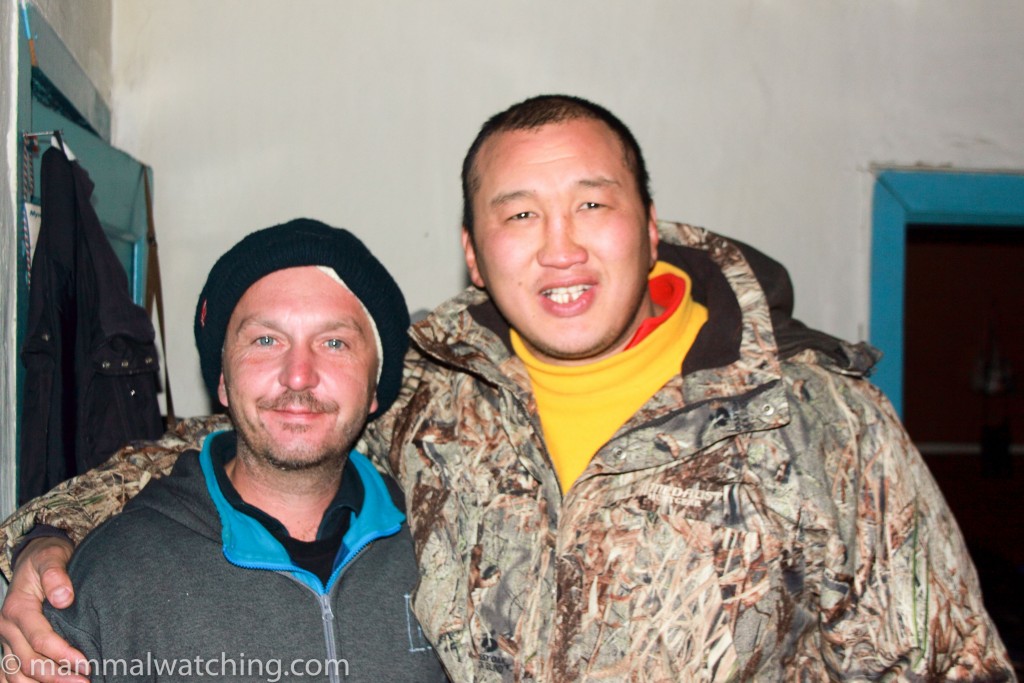
Ruslan and me
Ruslan Abasov was a legend in Krygyzstan – he won seven kick boxing world championships and was also a successful boxer who had lived in Vegas for 2 years. He was a Kyrgyz celebrity. His popularity was probably the only reason we managed to get the permission to travel we needed and didn’t get any problems at the various checkpoints. Tragically I learned he was assassinated in a car bomb in 2014. I liked him a lot – he couldn’t do enough to help, had a great sense of hunour and was also very knowledgeable about the wildlife and dreamed one day of someone making a Snow Leopard movie at his camp.
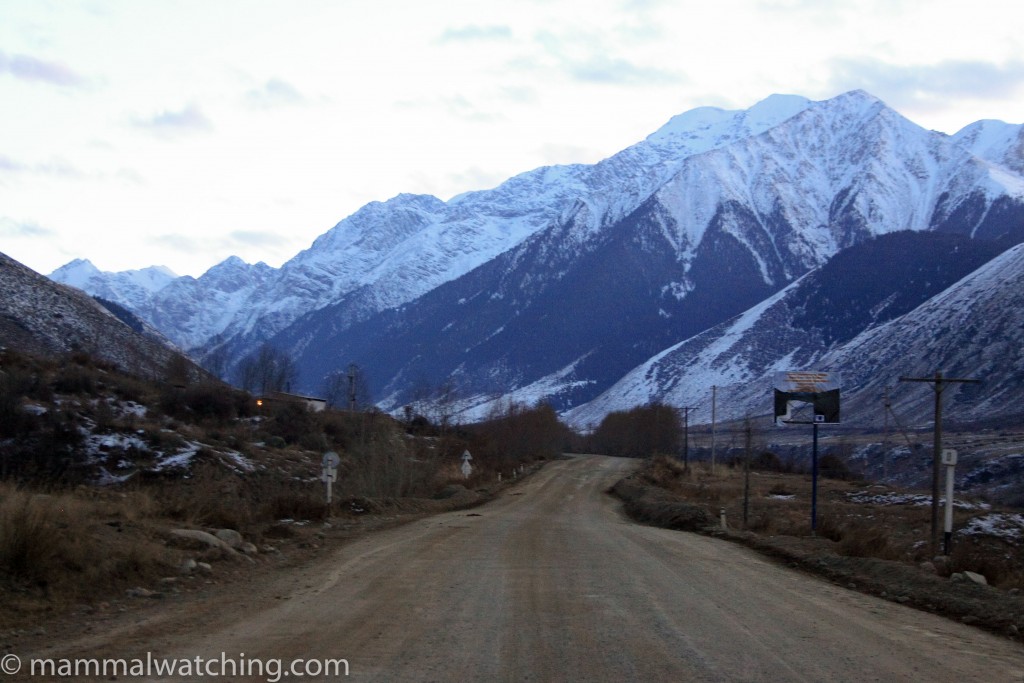
The start of the road to the mountains
So just as it was getting dark we headed off on what was to be one of the most adventurous drives of my life.
For the first hour or so the road was good. As we started to climb higher it became a snow covered track, often with steep drops on either side, and the 4wds had a tough time getting up some of the steeper sections. This was slightly alarming. In between wondering whether we would slide off the road and die, I smiled to myself remembering life as a kid growing up in Wales. If there was so much as a flake of snow spotted within 30 km of my school we would all be sent home so that the teachers could drive home safely. And as soon as any snow actually hit the ground, the whole town began driving at 10 kmh yet still crashing into each other. How I wish I could arrange an exchange visit with Kyrgyzstan.
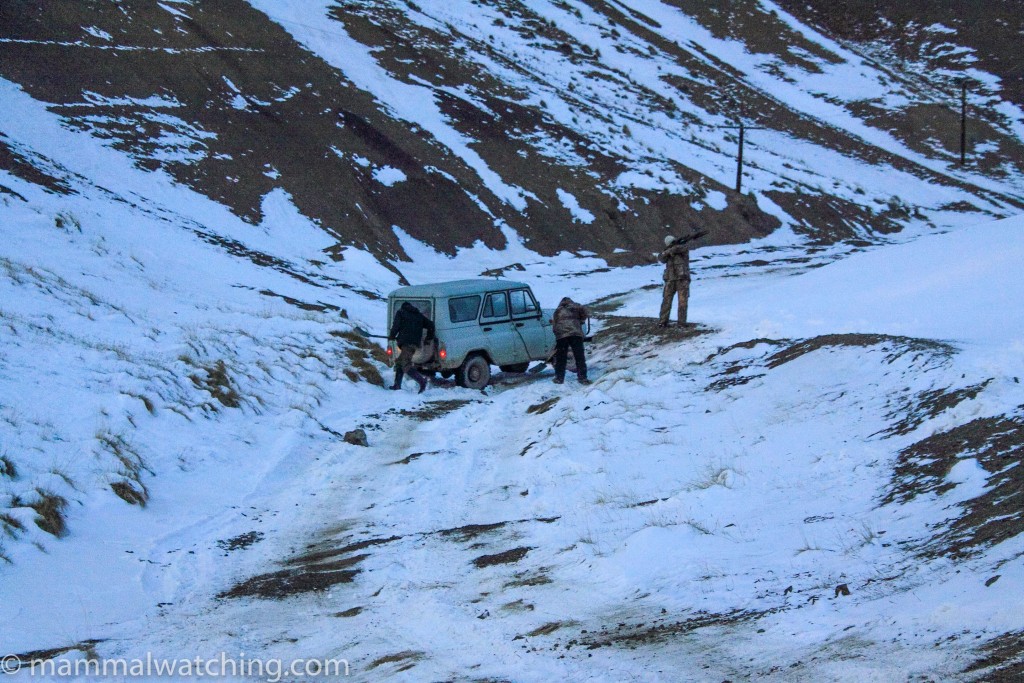
The full moon that night meant we could see the 5,000 metre peaks encircling us. By 10pm the temperature had dropped to -26 C and we stopped at a army post so they could check our permits. I felt I was in a scene from a James Bond movie. The sort of opening scene where the 4wds stop at a military checkpoint and the text rolls along the bottom of the screen ……December 2… Kyrgyzstan/China border area. It was beautiful, adventurous and I was far enough out of my comfort zone to be uncomfortably excited.
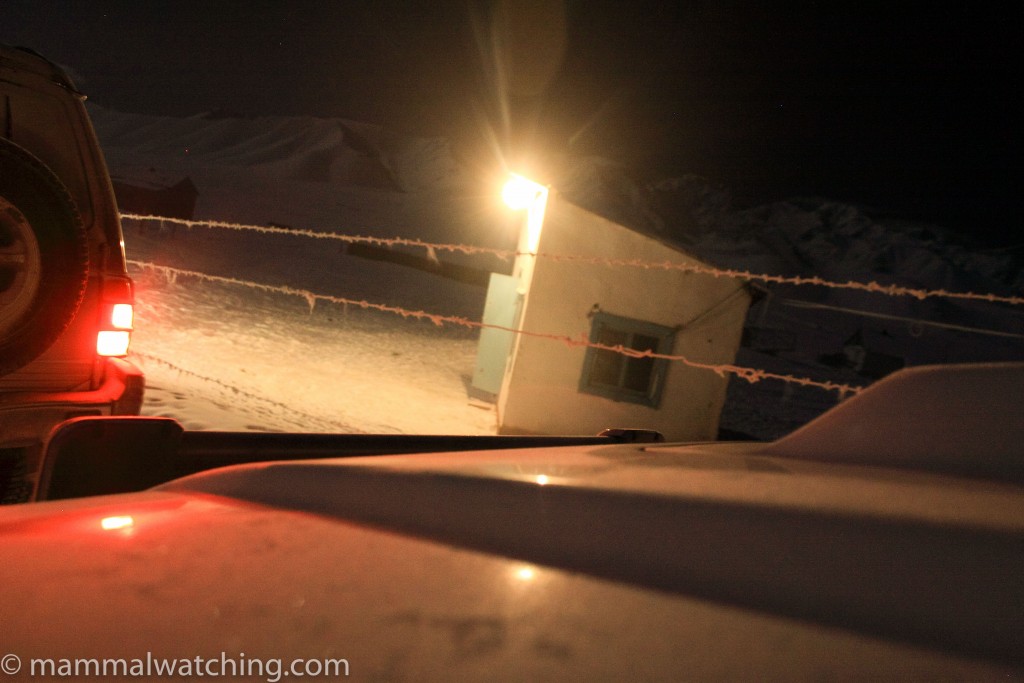
….December 2 21:00….. Kyrgyz/Chinese border zone ….
The road didn’t get any better and the temperature didn’t get any warmer for the next couple of hours, but eventually we arrived on a plateau where there was very little snow. We hit a Red Fox on the way – given that the road probably sees about 1 vehicle a week it was a very unlucky fox. The guys decided to keep it – in fact if they hadn’t chased after it and grabbed it maybe it would have survived to hit a car next week. But instead it was stuffed behind the bullbar like some bizarre mascot.
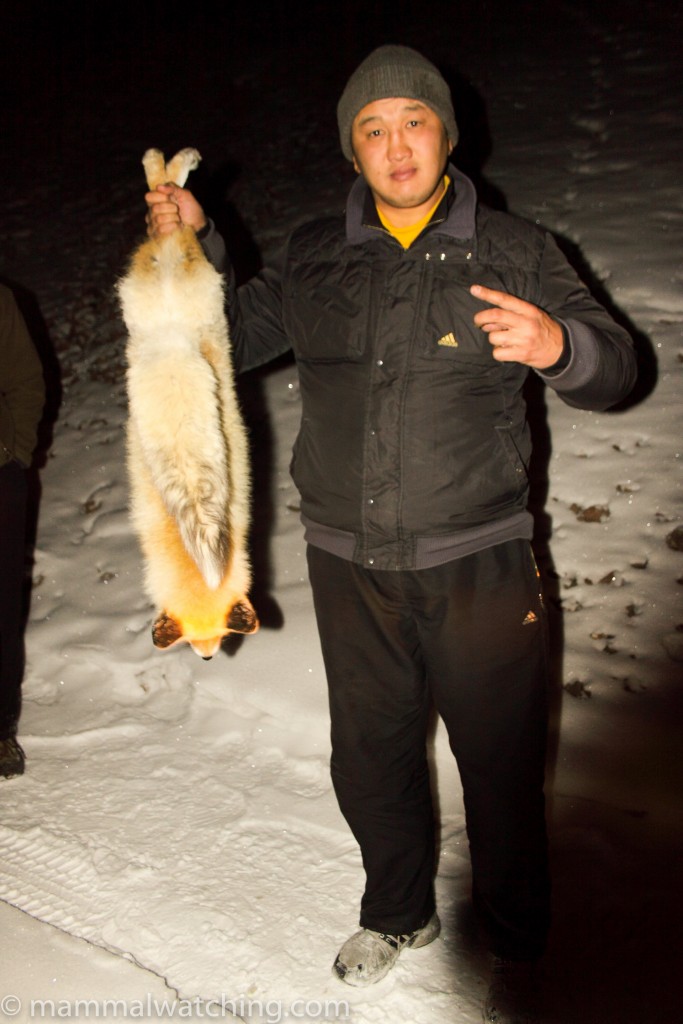
Red Fox and Ruslan
By midnight we were 120 km from the nearest road or settlement of any description. We tried to get accommodation in a hut, where I expected Ossama Bin Laden to greet us. I’m sure the American satellites were watching with interest what the three 4wds were doing pulling up here at midnight.
Ossama didn’t want company so we were sent 6kms down a track to a neighbouring shepherd. Judging by the chain and 6 padlocks on his gate I don’t think he wanted company either. But that wasn’t going to stop the likes of Ruslan who pulled out a massive iron bar and snapped the padlocks. This iron bar was the most useful piece of equipment in the car: it was used later to smash the ice on the river so the little Lada could exit a river it was driving through.
Judging by his locked gate I imagine the shepherd was surprised to see us but he was persuaded by Ruslan to offer all ten of us a place to sleep, eat and drink tea. Our group now comprised me and the two Danes, 3 drivers including Ruslan, a chef, some guy with a gun who wanted a ride from the checkpoint, Misha our guide and interpreter from Bishkek, and Alexei one of the Snow Leopard trackers. At 2 a.m. I lay on the floor inside a sleeping bag, wearing every bit of clothing I could find, and was lulled to sleep by the rumble of many Kyrgyz snoring.
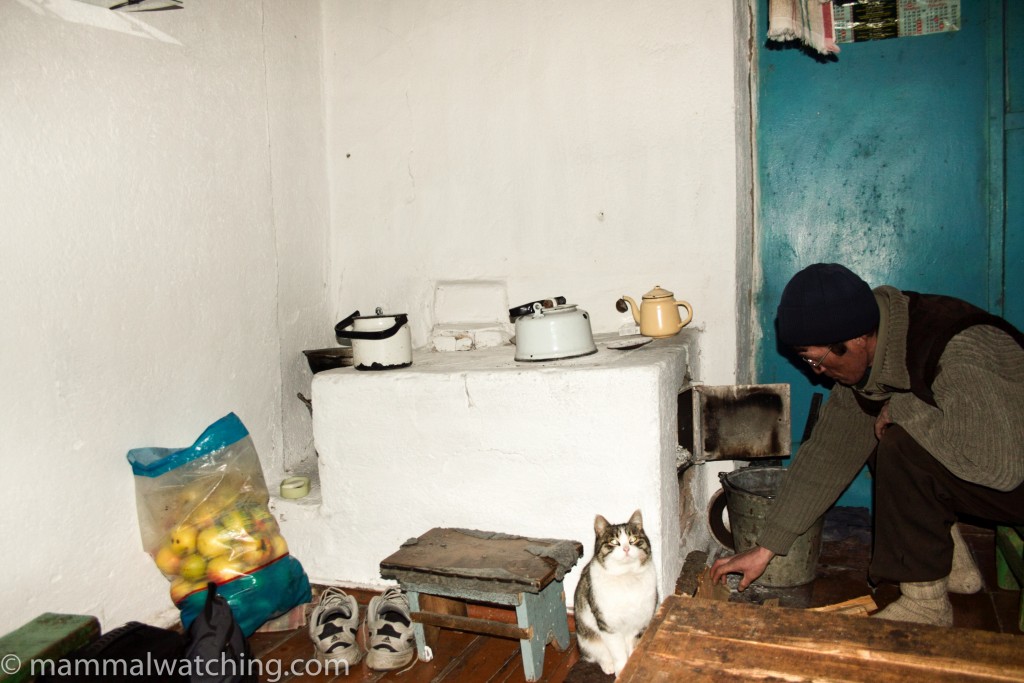
Shepherd’s House
3 December
We were up surprisingly early. As I was waiting for breakfast Ruslan started playing some music on his phone. It was a special Kyrgyzstan moment: it is not so often that I have waited for breakfast in a shepherd’s hut, probably the first westerner ever to have even seen it, sitting next to a World Champion kick boxer listening to Boney M.
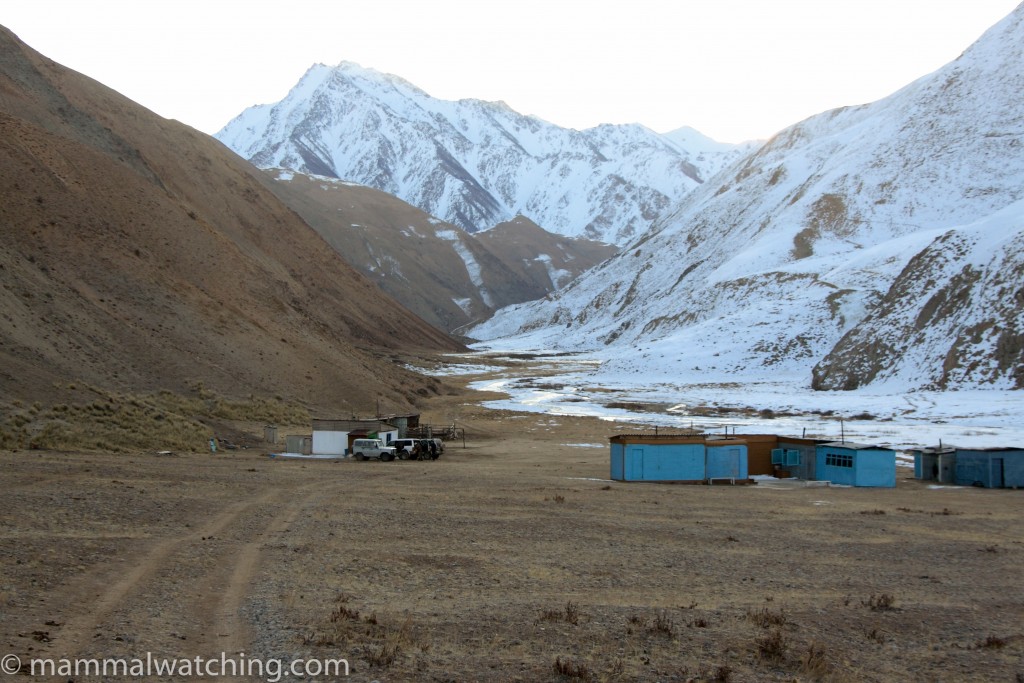
Camp on the first night
By 8 a.m. we were on the road again. But not before we’d had some porridge and seen our first Siberian Ibex and Argali (or Marco Polo Sheep). Michael had seen 10 Argali during the past decade in Kyrgyzstan and we saw six before breakfast here. It really did seem we had found mammal Shangri La he had been told about.
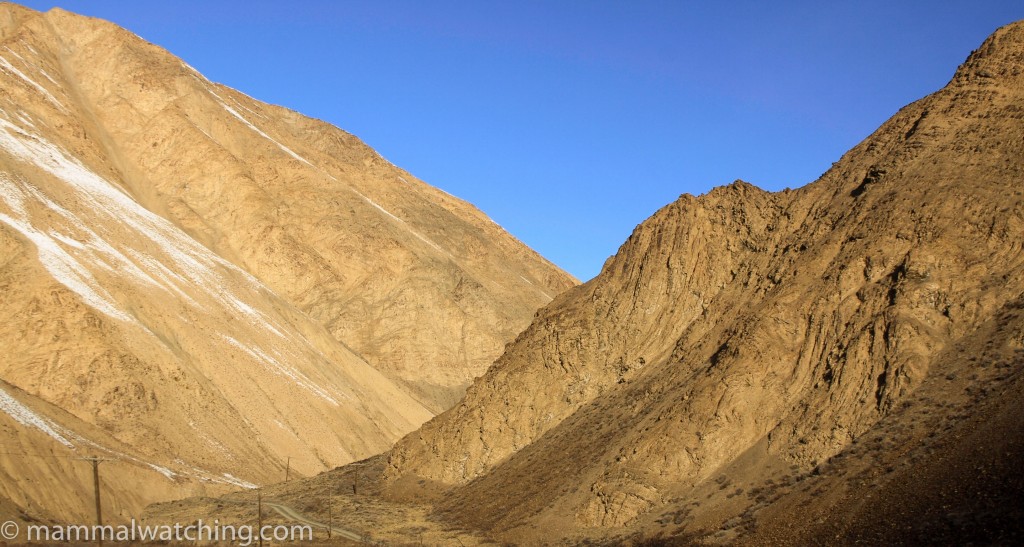
Road into the Tian Shan Mountains
The final 80 km to Camp Snow Leopard took us until 3 p.m. It was a spectacular drive in every sense. I cannot find superlatives to do it justice so will just say that in all the travelling I have ever done I have never experienced anything so beautiful, remote or adventurous.
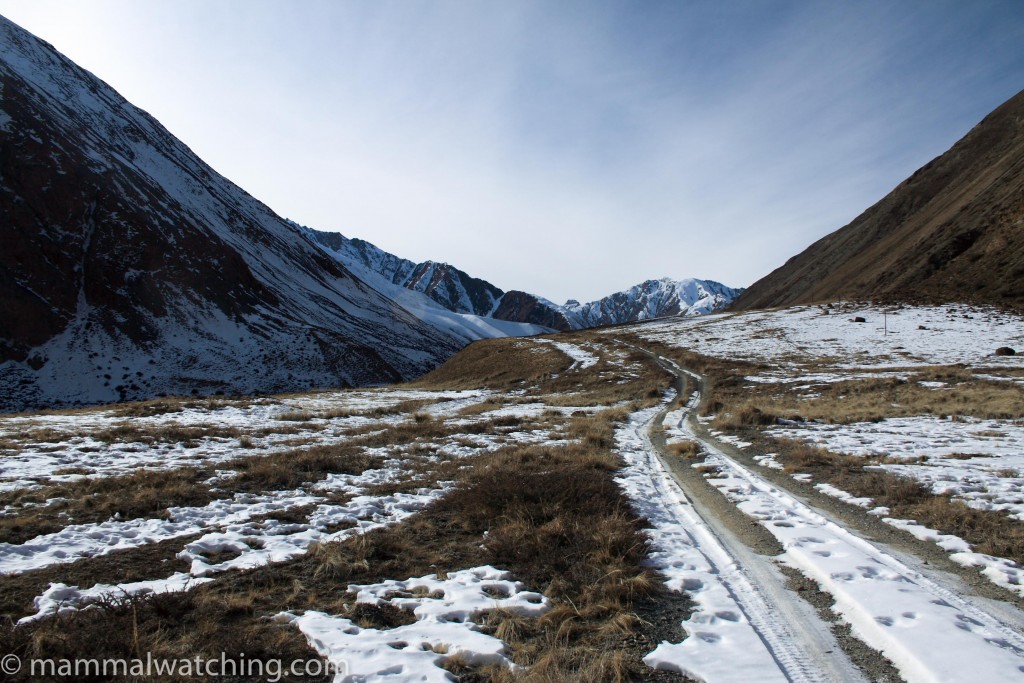
Road into the mountains
The day’s highlights included seeing many Griffon Vultures and Lammergeiers, including a group of seven of the latter species, which Michael thought unprecendented and showed the abundance of game in the area; having to avoid landslides by driving over into and along rivers; sliding down steep slopes that were sheet ice; and eating morning tea at the Chinese border post.
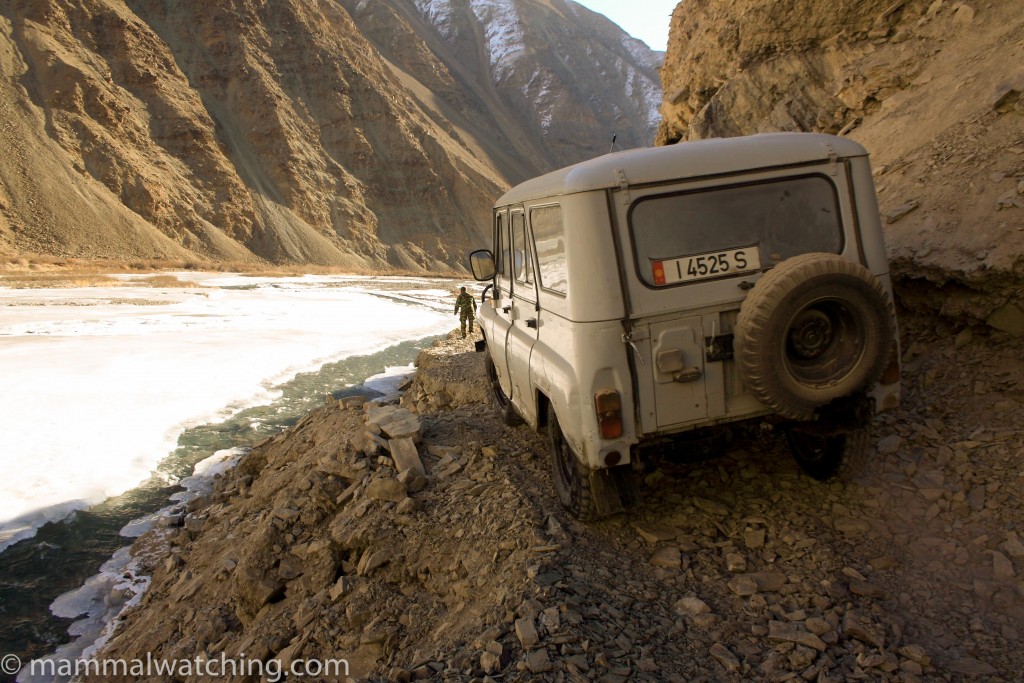
Road into the Tian Shan Mountains
Kyrgystan had recently ceded some territory to the Chinese and we had to pass through this on the way. The Chinese Army clearly don’t get many visitors. No one wanted to see our papers. They preferred instead to insist we let them feed us half a sheep. A couple of crappy videos of the drive taken with my phone are here and here.
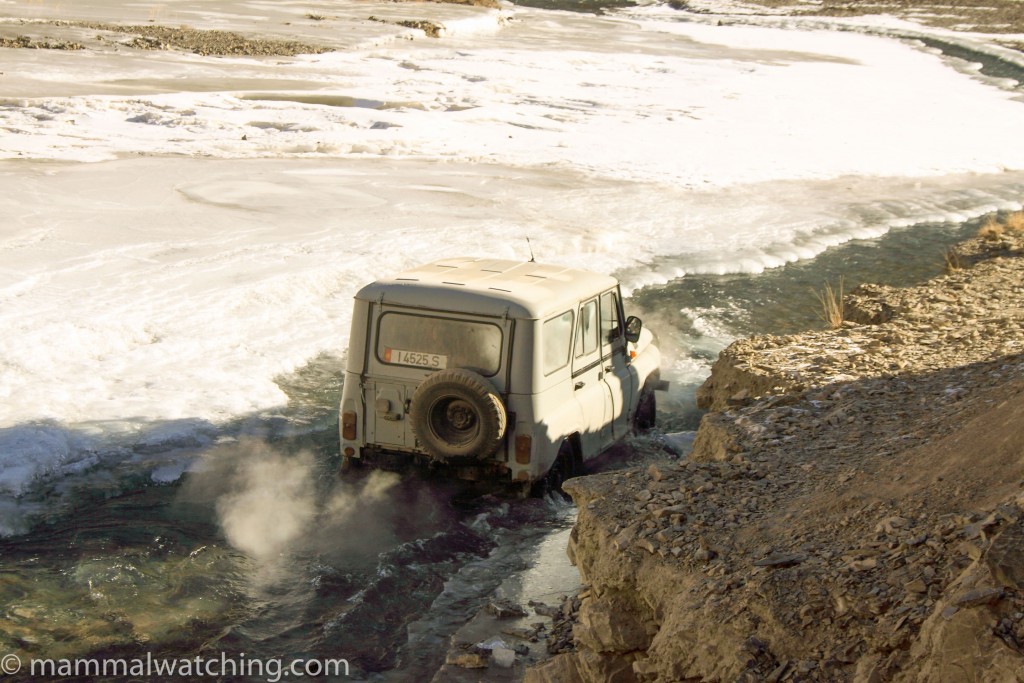
Road into the Tian Shan Mountains
Just 6 km from Camp Snow Leopard we almost lost the Lada jeep down the scree slope at a spot where the road had collapsed in a landslide. So we had to abandon the 2 Pajeros and shuttle to camp in the Lada. A tragedy as our supply of beer was left in the Pajeros.
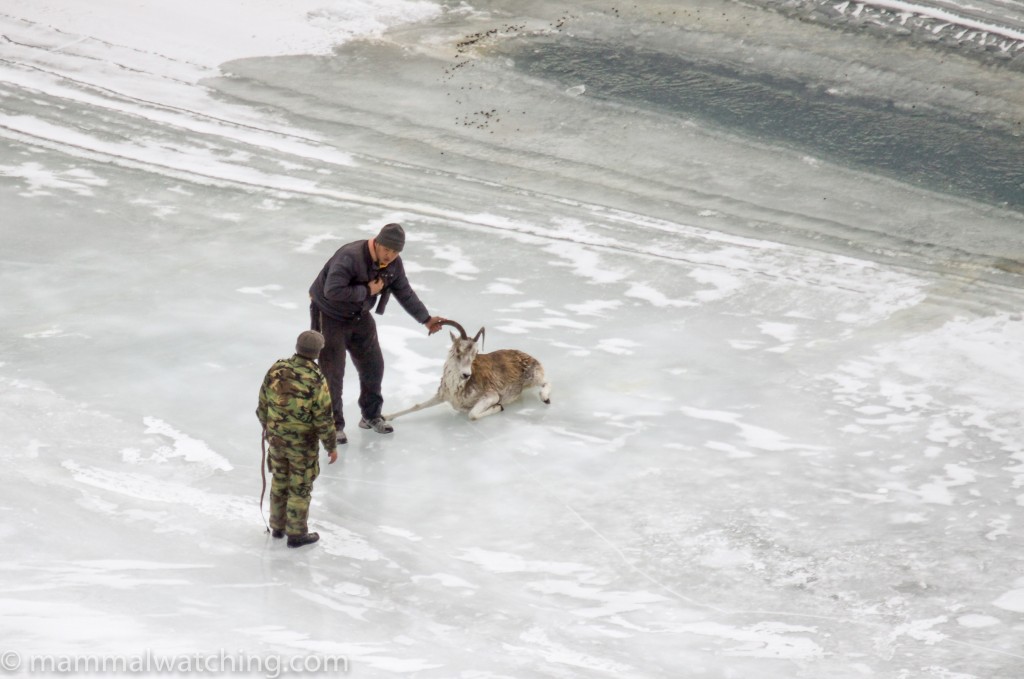
Ruslan and Jackie Chan rescuing an Argali
The last 6 km was as eventful as the previous 75 km. Some Marco Polo Sheep shot in front of the car and down the scree slope. We spotted them a couple of minutes later stuck in the river and unable to clamber out onto the ice. So Ruslan and the Lada’s remarkably fearless and skilled driver ‘Jackie Chan’ (I never got his real name) walked down to the river and pulled them out.
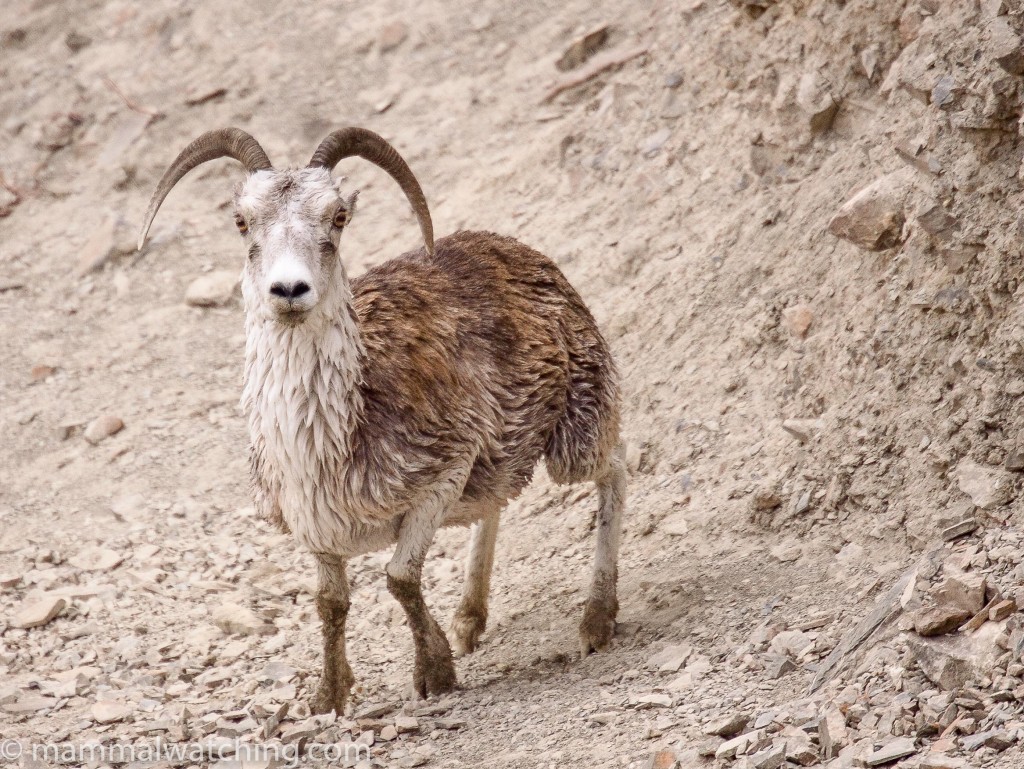
Argali or Marco Polo Sheep, Ovis ammon polii
As we approached camp we must have seen well over 100 Argali dotted across the plateau along with a couple of Tolai Hares and numerous Siberian Ibex on the cliffs. Michael was ecstatic: he had never seen concentrations of animals remotely like this elsewhere in Kyrgyzstan and that, together with the broad slab of open country we could see, meant the chances for Snow Leopards were as good as they get.
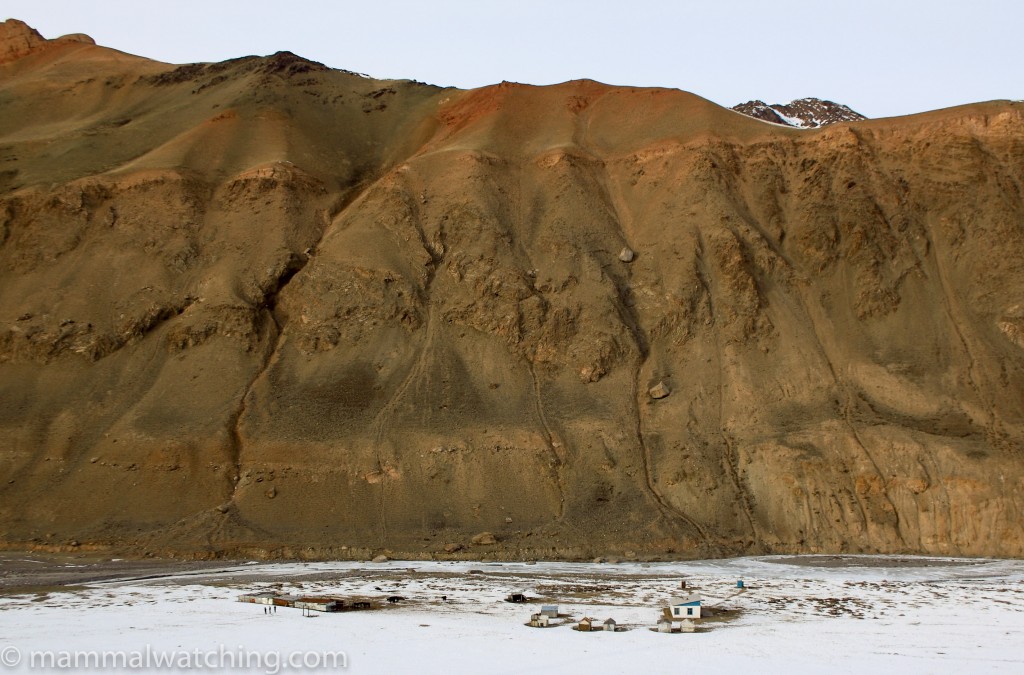
Camp Snow Leopard
Ruslan’s camp was relative luxury. We had a four room hut, with heating, beds and the promise of electricity when the generator was repaired. It was warm, comfortable and far better than any of us had expected. I took a short walk that afternoon around camp: seeing more Ibex and Sheep of course, and chatting with the rest of the crew who only gave up on fixing the road after dark. Dinner – soup again – took forever to arrive, but it was a very cosy atmosphere.
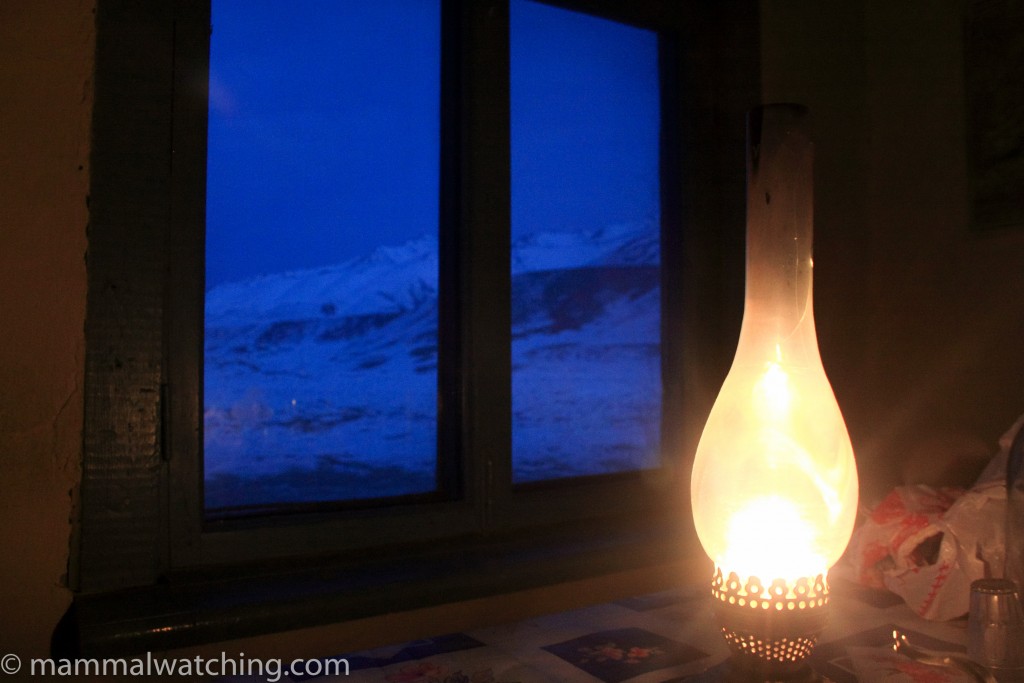
Dinner at night
4 December
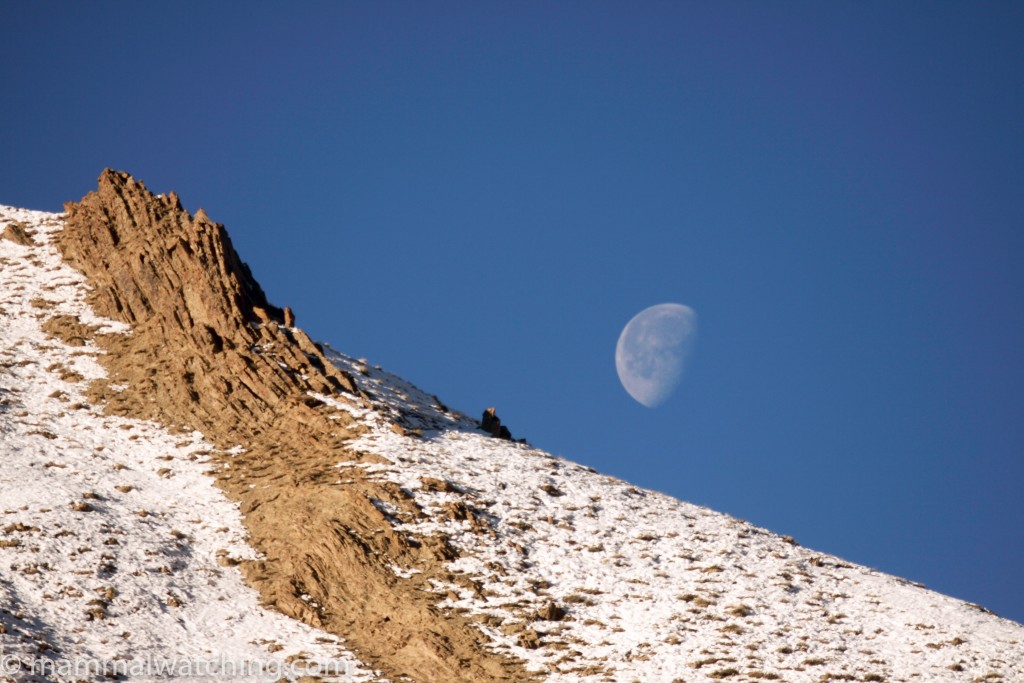
Full moon at dawn
We were away by 7 a.m. for the first day of searching for Snow Leopards. The guides, may well each have seen more Snow Leopards than anyone on earth, so we were in good hands. We followed us along a trail out of camp and then up a frozen river through a steep gorge. A Snow Leopard had been seen here a week before. Although it was pretty flat, the walk was tiring because we spent a good deal of time walking over the ice and trying to stay upright, none of us were totally successful. I learnt quickly that when there was some snow on the ice it was fine to walk quickly, but when the ice was rough and snowless, proceed cautiously in a sliding motion. And when the ice is polished prepare to fall over.
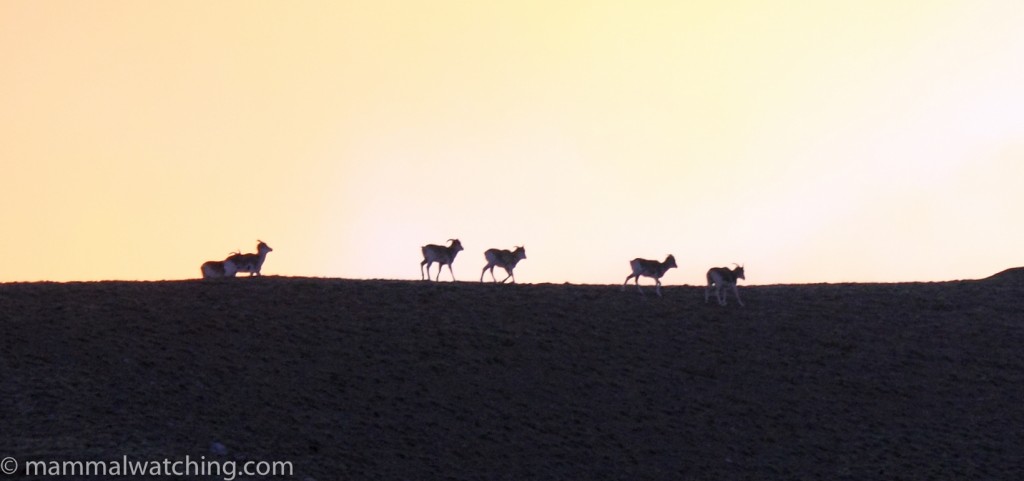
Marco Polo Sheep, Ovis ammon polii
We found an old leopard track, probably from the animal that had been seen a week before, we could find any fresh tracks. There were fresh Pika, Fox, Wolf and mustelid tracks and we saw several Ibex and Argali and a few Tolai Hares near camp.

Snow Leopard track
The scenery was of course spectacular and it was surprisingly warm by the time we got back at 12.30.
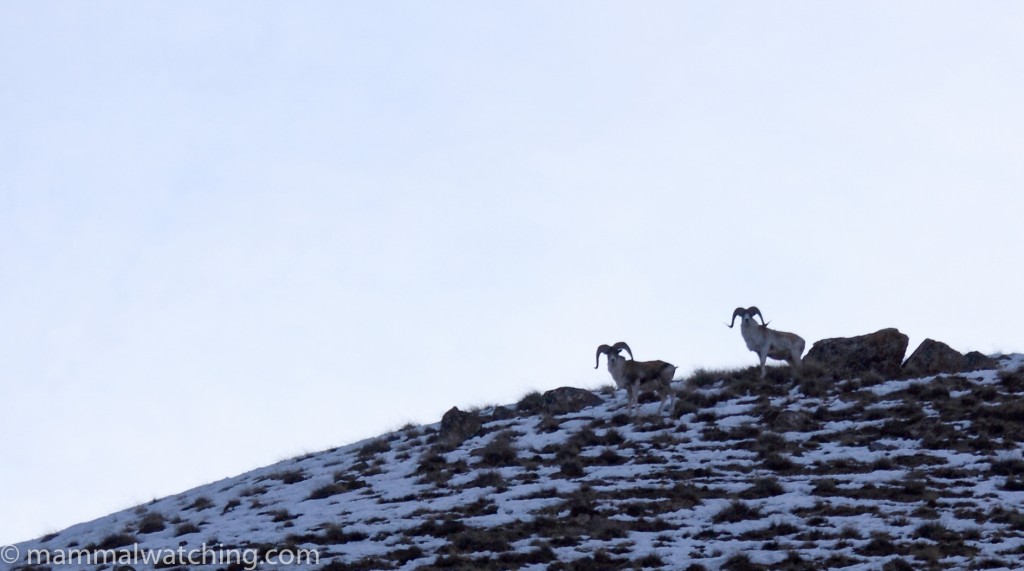
Male Marco Polo Sheep, Ovis ammon polii
After lunch, we went out for a shorter walk, along the ridge just south of camp. The chances of seeing a Snow Leopard here seemed much better than this morning because of the big slab of country we could see. But despite several hours staring we couldn’t turn up a “Bars”, the Russian name for a Snow Leopard.
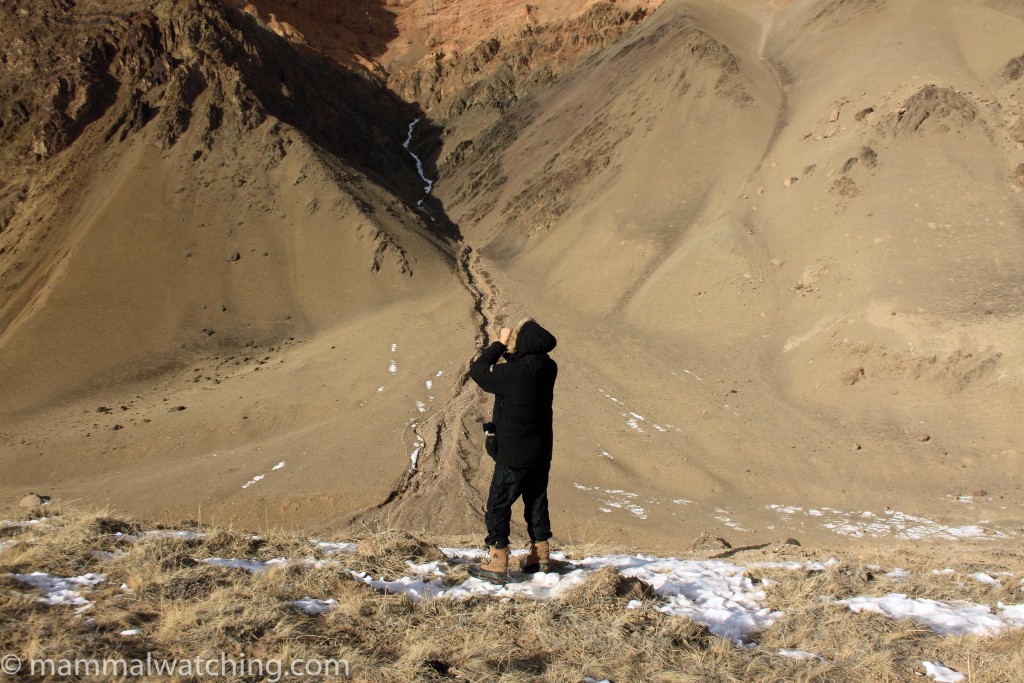
Looking for Snow Leopards
That night we feasted on freshly made manta, a sort of mince and onion Chinese dumpling – the mince was Argali. I was impressed that I managed to stay up past 8pm. But only just though, and then I didn’t sleep for long. I woke at 10 p.m. and got up to find the guys having a second dinner of various cuts of Yak. It would have to be a pretty limited menu before I order it again: the sausage of pure Yak fat was particularly gross (and this comes from someone who loves Black Pudding).
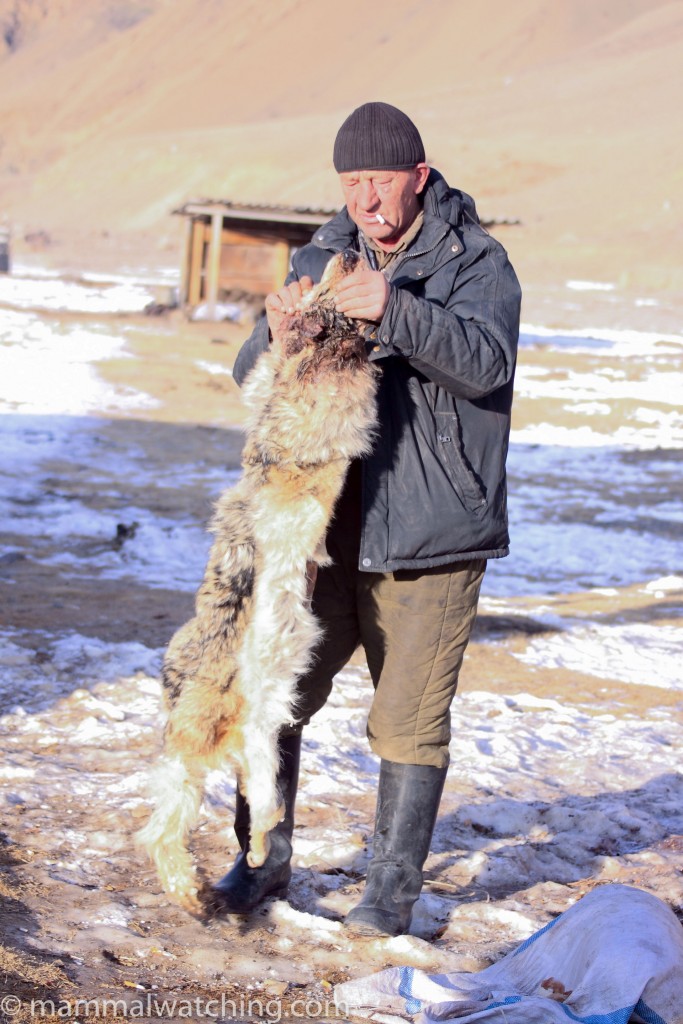
Nicolai and a Wolf skin
Ruslan and a few others went out for a couple of hours to try to shoot Wolves but didn’t manage to find any (a performance that was repeated every night). Wolves are plentiful in Kyrgyzstan and are loathed even more vehemently here than most other places I have been. Wolves are apparently responsible for all manner of terrible things and occupy a place in the Kyrgyz heart that other nations save for the French soccer team.
5 December
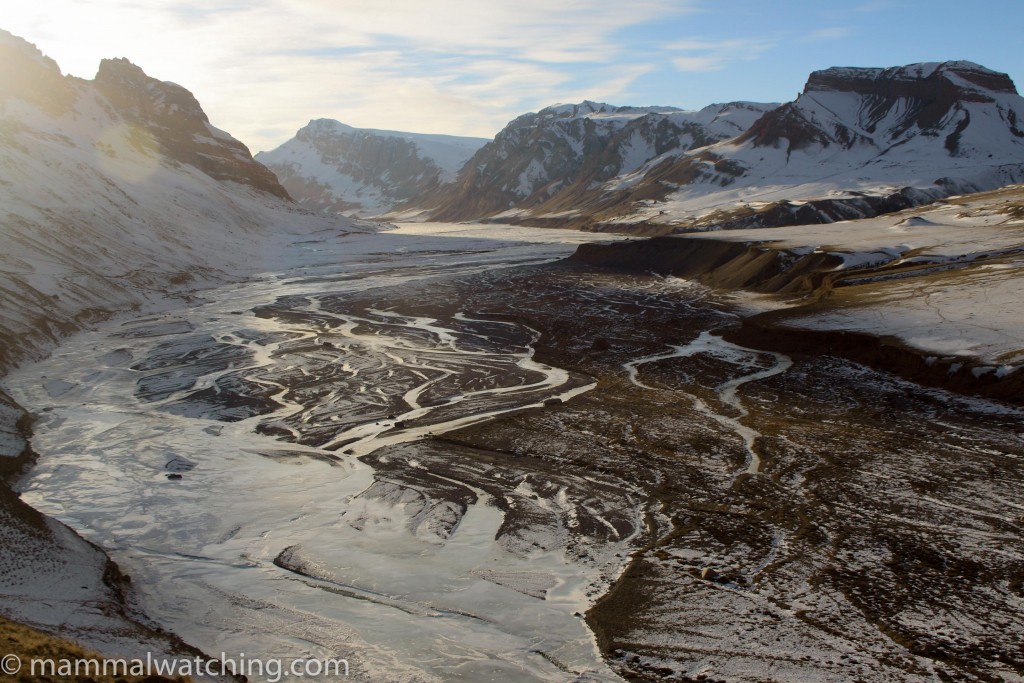
Tian Shan valley
It took a while to get the horses ready in the morning so our planned 8 a.m. departure was at 9 a.m. We were six, with four horses, and I quickly discovered that horse riding is a nice to travel in the mountains. I have ridden a horse fewer than a dozen times before, and never with confidence. But if you can ride a Donkey on the beach then you can ride one of the horses here. Kyrgyz horses are slightly larger and considerably slower than the average donkey. But they are sure footed on the narrow trails, knew where to go, and were far better skating across frozen rivers than I was, even if the ice cracked and began to give way several times.
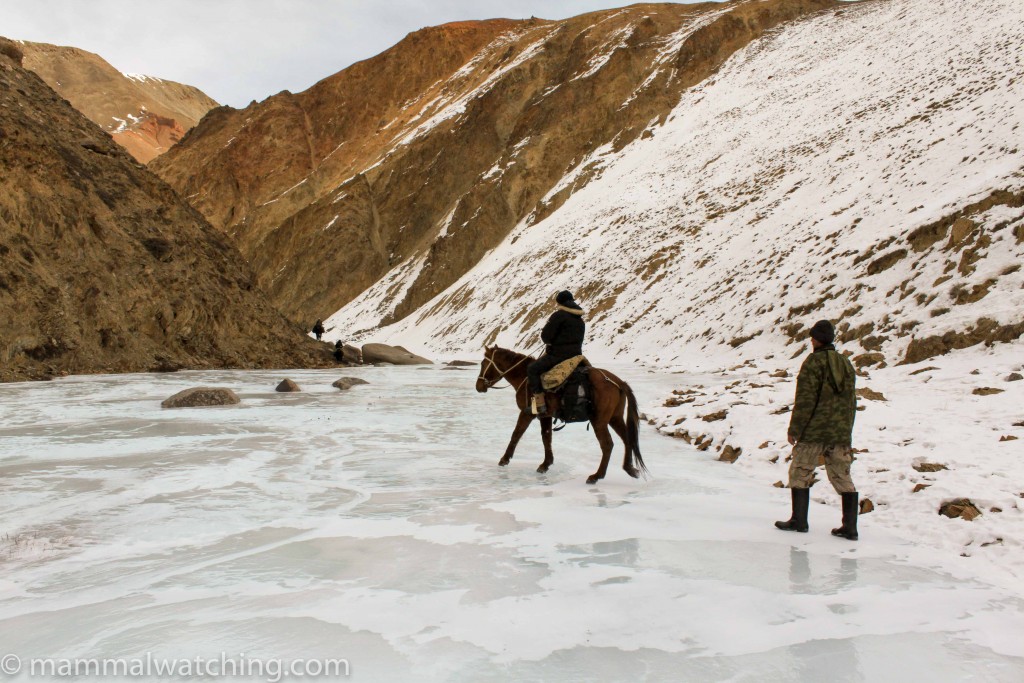
Ice riding
We travelled about 6 km up another river gorge. Another crappy video from my phone is here. About 5km up we found the first fresh Snow Leopard tracks (perhaps a day old) and soon after we found a whole mess of tracks: four or five animals the guides thought. The gorge was a well known Snow Leopard haunt and somewhere animals would often cross or travel through. Sadly we also found some snares that had been set for Snow Leopards.
But despite several hours scanning the cliffs and walking up the gorge slowly we couldn’t find an animal. They were likely sleeping in the afternoon on the rocks but not where we could see them. We did see about 50 or so Argali and 100+ Siberian Ibex during the day, along with numerous vultures.
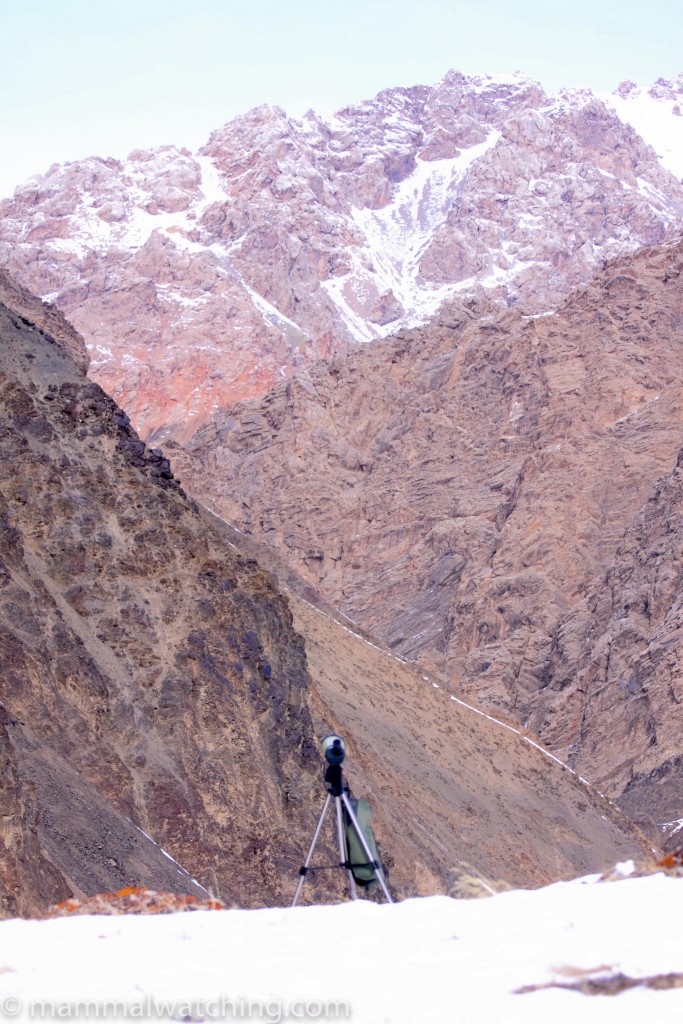
Snow Leopard habitat
We got back to camp just after 5 p.m. and Ruslan proudly served up a selection of hors d’ouevres, all of which featured various quantities of pork and lamb fat (ranging from 20% to 100% fat). And very tasty they all were.
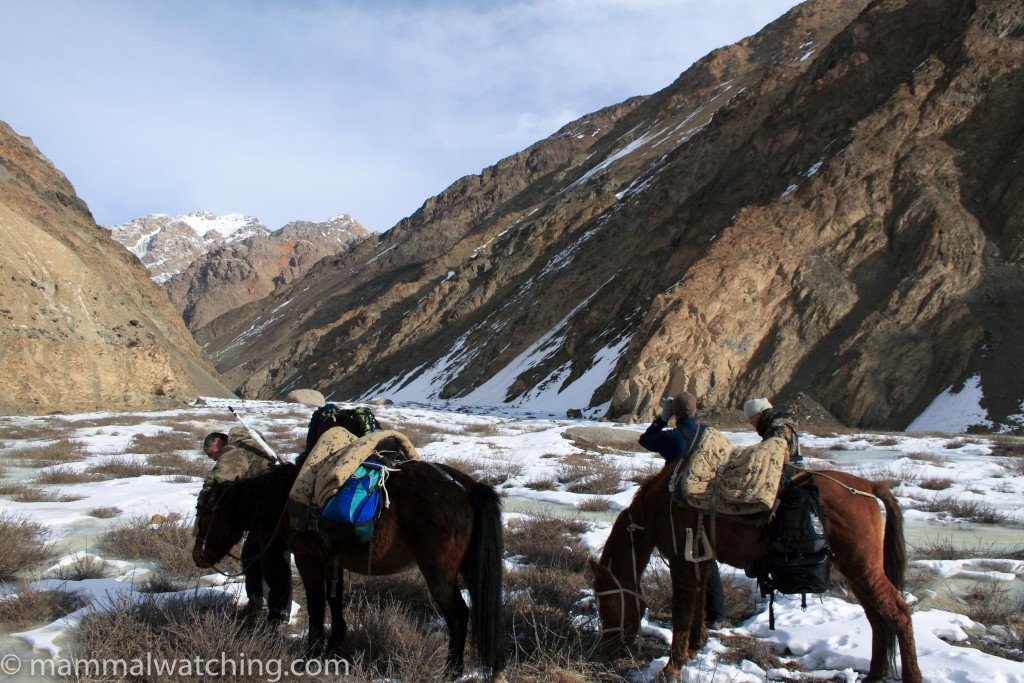
It was a fabulous day. I often tell the uninitiated that mammal watching is fun because of the places it takes me. This is only half true because I often don’t pay much attention to the scenery when I am focused on the animals. But it is different here. First, it just isn’t possible to ignore the scenery. Second, the adventure and remoteness is unforgettable. And third, because I was only focused on Snow Leopards I had little choice but to gaze at the mountains around me. Now I understand more the connections between zen and Snow Leopard searching in Peter Matthiessen’s book of the 1970s. I really was in a different zone looking for this creature.
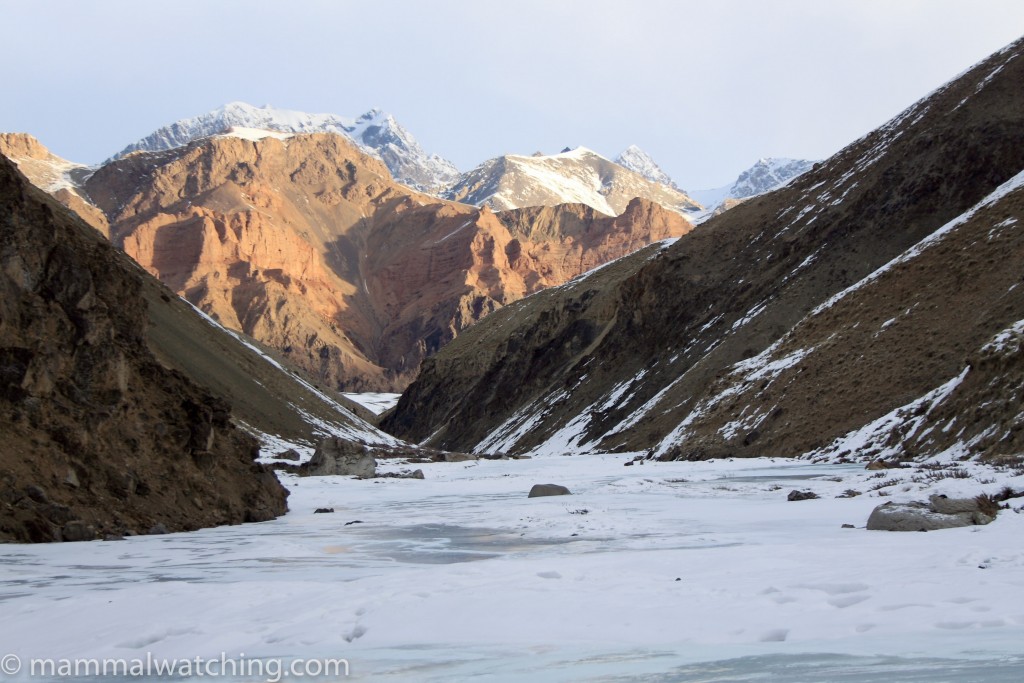
Tian Shan scenery
Dinner was a fried variation on last night’s manta theme. I wished my beer from the Pajero had turned up. Later that night the hunters in the camp compared knives and AK47s before heading off to try to shoot some Wolves. Just another night in Camp Snow Leopard.
6 December
Today we were heading back down the road from camp about 10 km and then walking down another gorge that was reputed to have a healthy Snow Leopard population. The Lada’s indomitable driver, ‘Jacky Chan’ took us back down the road as far as the landslide, which we walked around and then picked up the petrol Pajero, when we found the diesel was frozen solid in the other car. Even Jackie Chan on his blow torch couldn’t get it started.
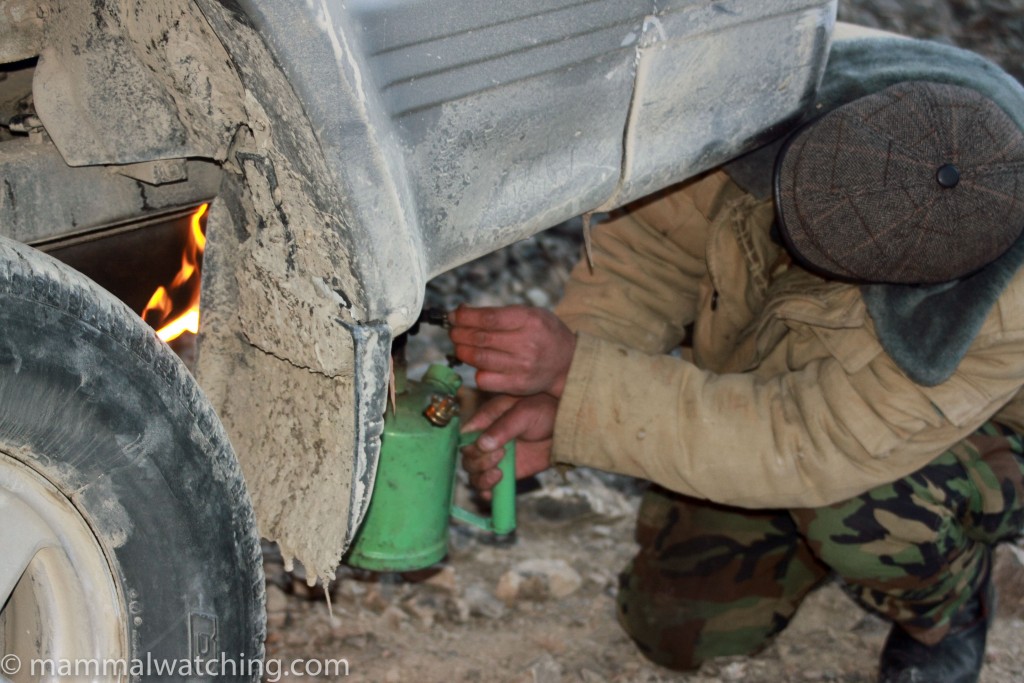
Jackie Chan ignore health and safety warnings
The weather was colder than it had been, but the scenery was just as spectacular. The gorge was easier to walk down than the other two as it was wider with a well-defined trail most of the time alongside the river, and less need to slide across the ice. Today we were accompanied by Nicolai, the most experienced guide (he used to make a living catching Snow Leopards for Chinese zoos). Nicolai quickly found relatively fresh tracks (a couple of days old) and after a couple of hours walk he found more – this time perhaps only 2 hours old. We were close. But not close enough. The trail petered out after 30 minutes, and the trackers suspected the leopard had climbed up and over the ridge.
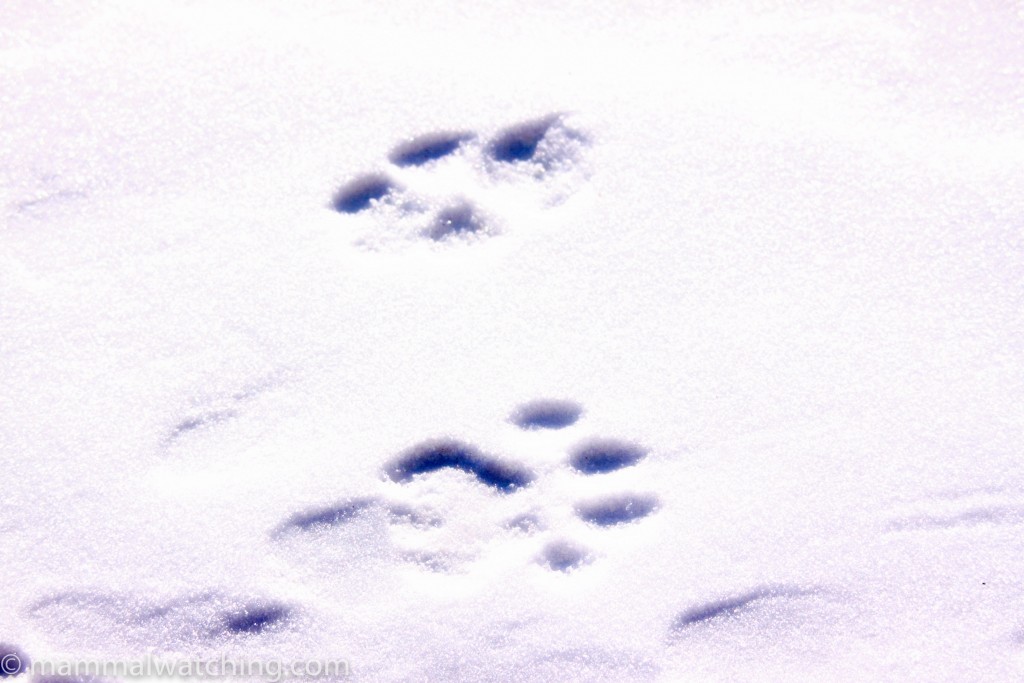
Snow Leopard (back) and Wolf (front)
We stopped for an early lunch then walked on til about 3 p.m. Plenty more Snow Leopard tracks, along with hundreds of Siberian Ibex during the course of the day, but we couldn’t find a Leopard. We made the most of the day though, getting back to the road at 5 p.m. after a walk of around 15 km.
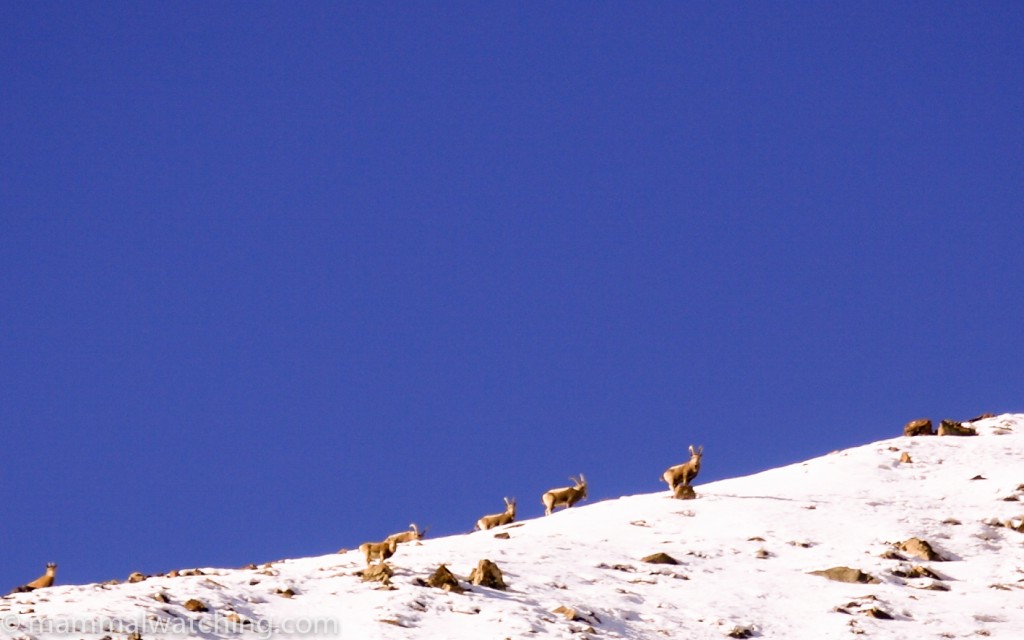
Siberian Ibex, Capra sibirica
Back at the Pajero we discovered the beer we had left in the Pajero – and had been dreaming about – was already at Camp Snow Leopard … we hadn’t thought to ask and they hadn’t thought to tell us. It was a perfect accompaniment to the night’s Russian variety of Wonton Soup.
7 December
We had intended to leave the camp this morning and travel back to Tamga but our failure to see a Snow Leopard persuaded Michael to spend aone last morning looking and we returned to the gorge we had visited the day before. No fresh tracks and no Snow Leopard 🙁

The journey back to Tamga might have taken 9 hours without interruption. But – aside from several stops for Ruslan to shoot Hares and Chukars – we had car trouble. The Pajero we were in had three flat tyres in the first 9 hours (probably more to do with our driver than the road I suspect) and the complications of finding spares meant we swapped the wheels around between the two Pajeros at least 10 times. We eventually abandoned the first Pajero at midnight near a checkpoint when the temperature had dropped to -30. Brrrrr. And then at 1 a.m. the Lada ran out of petrol (because it had had to keep turning back to look for our Pajero). So we got back to Tamga in the last remaining vehicle at 3 a.m. after a 15 hour drive.
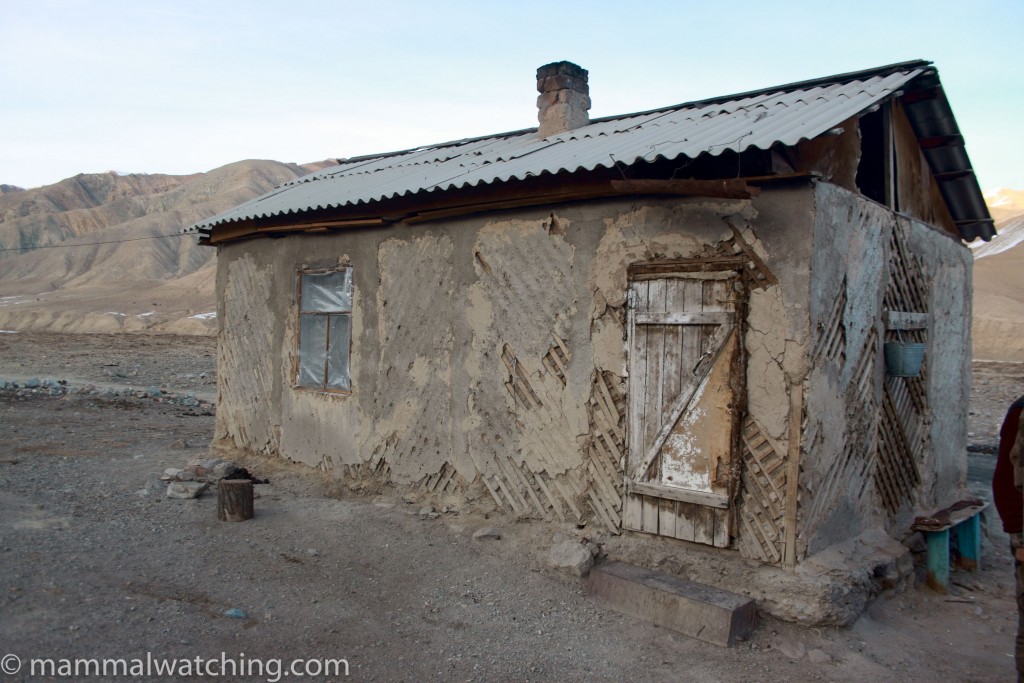
Shepherd’s hut
8 December
Our last day was spent waiting for our luggage to arrive in Tamga (it had been marooned in the Lada) followed by a 5 hour drive back to Bishkek. I left early the next morning.
So a great adventure. Of course a Snow Leopard would have made it greater but we found evidence of up to 10 animals in a small area. Often people can spend week’s looking for the sign of an animal. If we had had a little more time (we only spent 3.5 days looking) I am pretty sure we would have found one. As it is, we saw 4 species of mammals, 3 of them lifers for me.
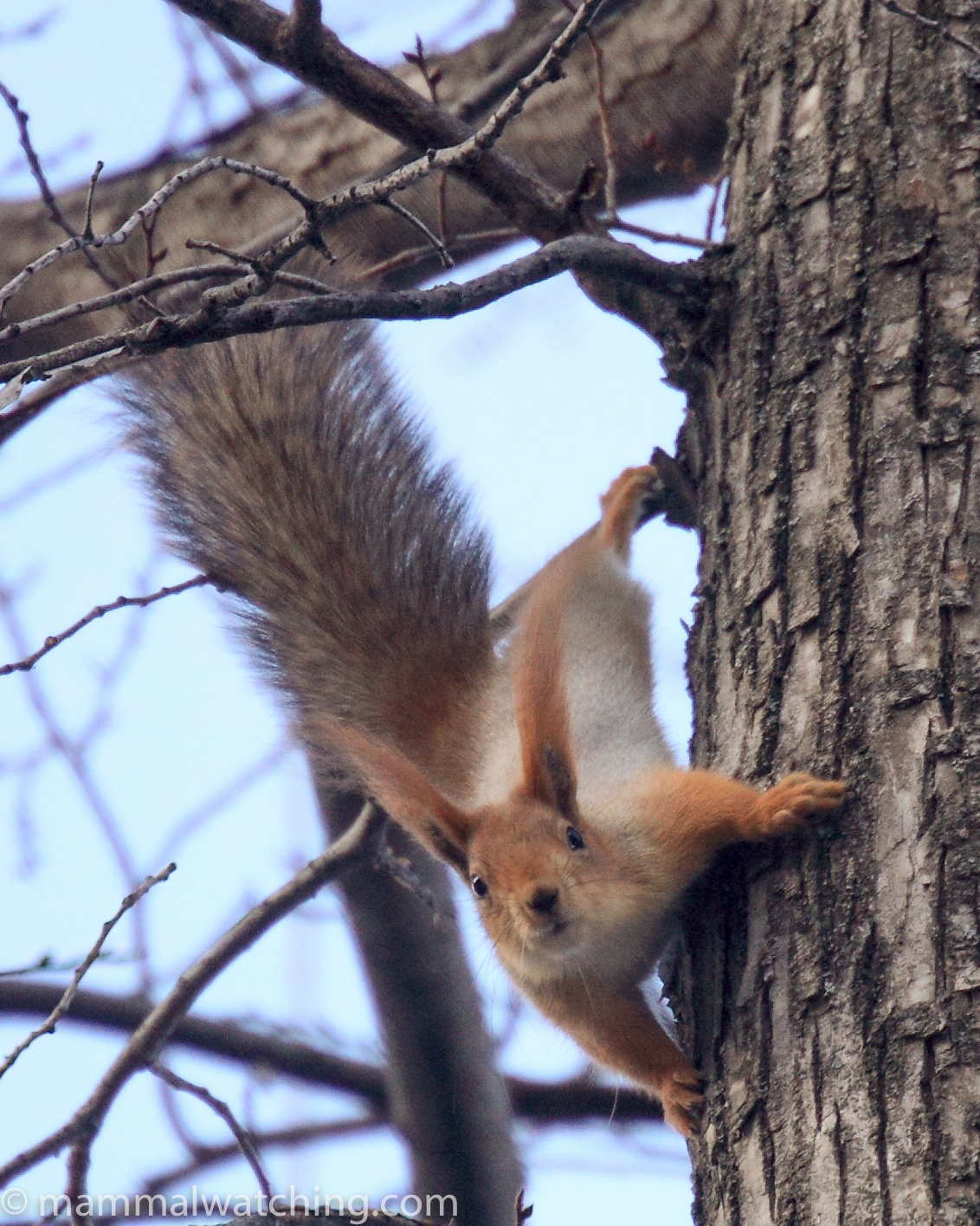
Eurasian Red Squirrel, Sciurus vulgaris
There are of course a few other mammals in the area which I didn’t – or couldn’t – look for. Marmots are abundant in the summer but of course were hibernating. I saw Pika tracks a couple of times but I guess these would also be more active when its warmer. Weasels – presumably Mountain Weasels – are also quite common and often caught by the locals in snares.
Elsewhere, and lower, in Kyrgyzstan, we were told that both Lynx and Pallas’s Cats are easy to see if you go out looking for dogs. Siberian Roe Deer and Asian Badgers are also common.
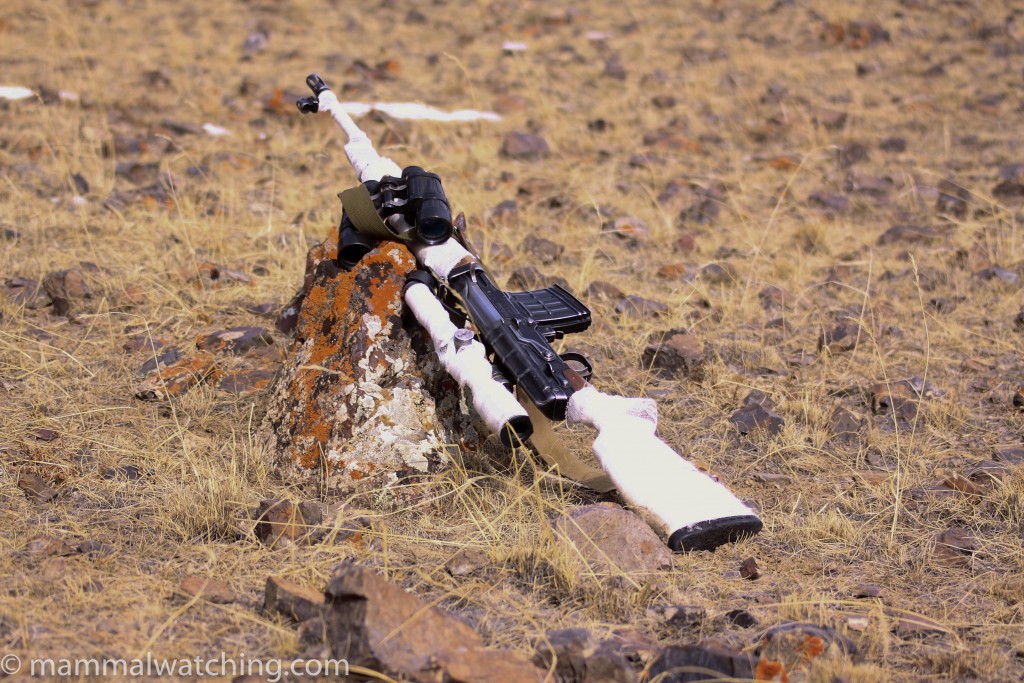
Community Reports
Kyrgyzstan. 2021: Brennig Hughes’s short report on mammals observed during a few months including Lynx, Snow Leopard and Argali.
Tien Shan Mountains, 2018: Ralf Bürglin, 3 weeks & 5 species including Snow Leopard, Siberian Ibex and Long-tailed Marmot.
Kyrgyzstan, Summer 2012: Erik Foekens, and a very interesting 2 weeks & 10 species identified including Steppe Polecat and Asian Badger.
Kyrgyzstan, 1989-90: Vladimir Dinets’s notes of various trips with species including Snow Leopard and Lynx.
Also See
Please email me if you have tips for mammal watching in this area.


Leave a Reply
You must be logged in to post a comment.